ETHOS

Psychological risk factors play a significant role in the occurrence and recovery from sports injuries among college athletes. These factors encompass a range of emotional, cognitive, and behavioral elements that can influence an athlete’s susceptibility to injury, response to injury, and rehabilitation outcomes. Here are some key psychological risk factors to consider:
Stress and Anxiety: High levels of stress and anxiety can impair an athlete’s concentration, coordination, and decision-making abilities, increasing the likelihood of sustaining an injury during sports activities. Moreover, anxiety can contribute to


Athlete Identity: For many college athletes, their sport is not just an activity but a fundamental aspect of their identity. Sustaining a significant injury can challenge this identity, leading to feelings of loss, frustration, and depression. Athletes who struggle to cope with the temporary loss of their athletic
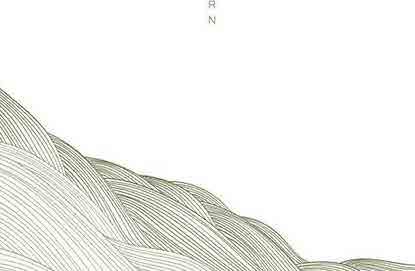

RESEARCH


The discussion revolves around the impact of psychological factors on sports injuries and the subsequent consequences for athletes’ health. Major life-event stress, such as significant personal events, has been consistently identified as a predictor of sports injury occurrence. Athletes reporting higher stress levels associated with these events are more prone to injuries, particularly when coupled with low coping skills. Research across different athlete populations, including NCAA football and hockey players, demonstrates the correlation between elevated stress and increased injury likelihood.
In the post injury phase, mood states exhibit dynamic patterns. Athletes experience negative moods from the presurgical phase through post operation, gradually improving during intermediate weeks, only to become increasingly negative as they approach the return-to-sport phase. These mood states have broader implications for health, influencing factors like wound healing through psycho-neuroimmunological pathways.
Despite sports participation being a common cause of injuries, it is also seen as a means of recovery. Engaging in alternative physical activities post injury, such as cross-training or working on uninjured body parts, provides psychological benefits and aids in the overall well-being of athletes. The parallels drawn with wounded military personnel highlight the transformative role of sports and competitive athletics in mental, physical, and spiritual recovery.

Targeting college athletes to educate them about sports injury risk factors, preventive methods, and mental health awareness is a proactive approach to promoting overall well-being and performance. Incorporated aspects can include:
Individual Consultations:
Offer one-on-one consultations with sports medicine physicians, physical therapists, nutritionists, and mental health counselors. Athletes can receive assessments, injury screenings, and individualized training plans tailored to their specific needs and goals.
Skill Development Programs:
Implement skill development programs focused on enhancing proprioception, balance, agility, flexibility, and strength to reduce the risk of injuries.
Injury Prevention Clinics:
Host injury prevention clinics where athletes can learn about common risk factors associated with their sport, such as over-training, improper equipment use, and inadequate recovery practices.
Mental Health Resources:
Establish a comprehensive mental health support system within the athletic wellness and training center, including access to licensed counselors, therapists, and support groups. Raise awareness about the importance of mental health maintenance, stress management, resilience-building, and seeking help when needed.
Collaborative Approach:
Foster collaboration between coaches, athletic trainers, sports medicine staff, and mental health professionals to create a
Physical Therapy Assessments:
Offer regular physical therapy assessments to identify musculoskeletal imbalances, movement dysfunctions, and areas of weakness or instability that may predispose athletes to injuries. These assessments can serve as a baseline for developing personalized injury prevention and rehabilitation plans.
Injury Rehabilitation Programs:
Provide comprehensive injury rehabilitation programs led by licensed physical therapists to facilitate safe and effective recovery from sports-related injuries. These programs may include manual therapy, therapeutic exercises, modalities (e.g., ultrasound, electrical stimulation), and functional training to restore mobility, strength, and proprioception.
Return-to-Sport Protocols:
Develop evidence-based return-to-sport protocols in collaboration with sports medicine professionals and physical therapists to guide athletes through the transition from injury rehabilitation to full participation in sports activities. These protocols should emphasize gradual progression, functional testing, and risk reduction strategies to minimize the risk of re-injury.
Preventive Exercise Prescription:
Prescribe preventive exercises and corrective movement patterns tailored to each athlete’s


DIVISION
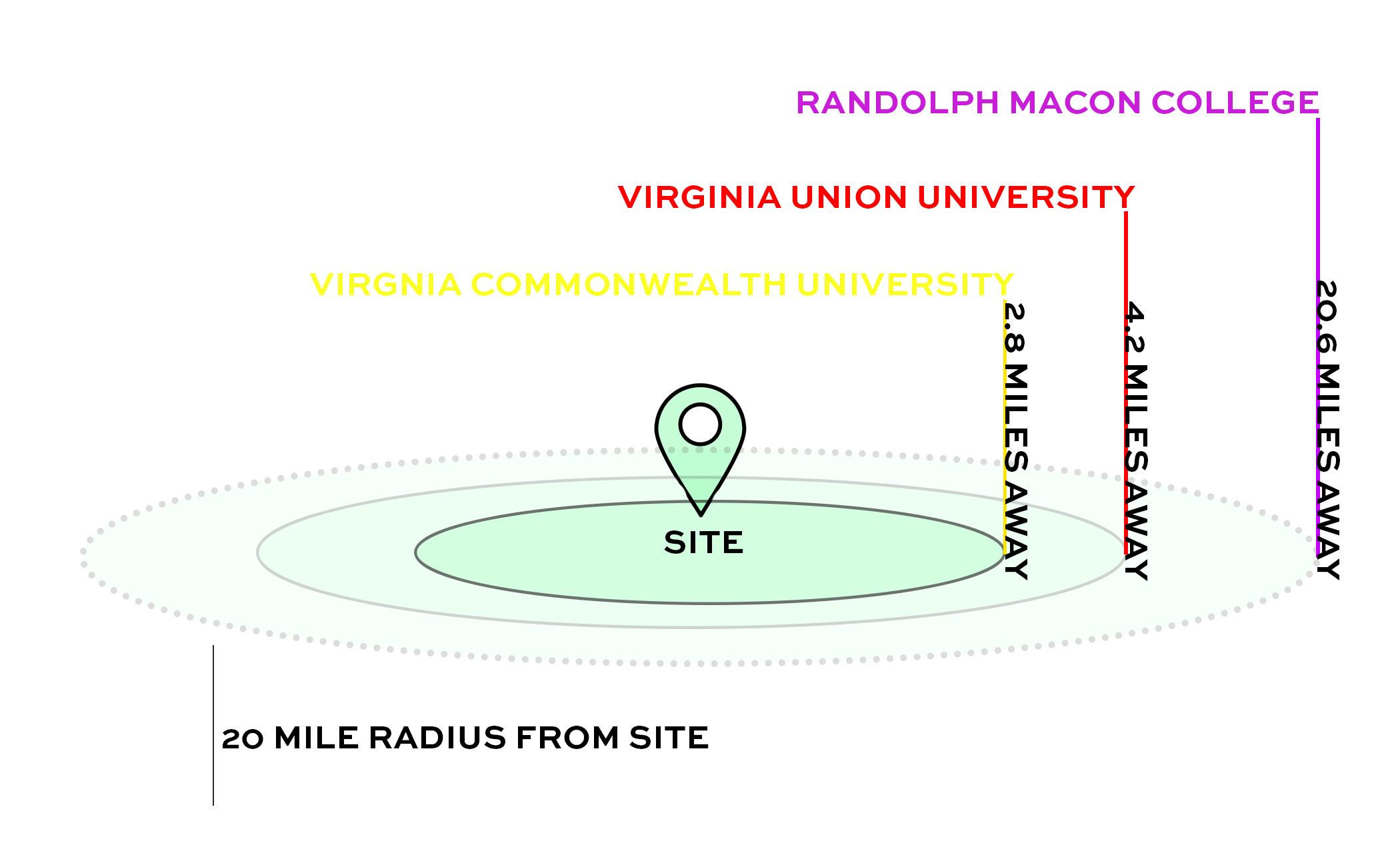

College athletes represent a crucial demographic for education and injury prevention in professional sports careers. These young athletes often possess immense potential but may lack the experience and knowledge to navigate the physical demands of their sport safely. By targeting college athletes, sports organizations can implement comprehensive education programs aimed at teaching proper training techniques, injury prevention strategies, and the importance of early intervention. By equipping college athletes with this knowledge early on, they are better prepared to avoid common injuries and develop healthy habits that can prolong their careers at the professional level. Additionally, fostering a culture of injury prevention in college athletics can have a ripple effect, influencing future generations of athletes to prioritize their well-being both on and off the field.
SCHOOL SPORT
Primary Target User Group : Active & Recovering Collegiate Athletes DIVISION


DIVISION




USER
I
II
III
Richmond Terminal No. 3 Warehouse : Location & Proximity
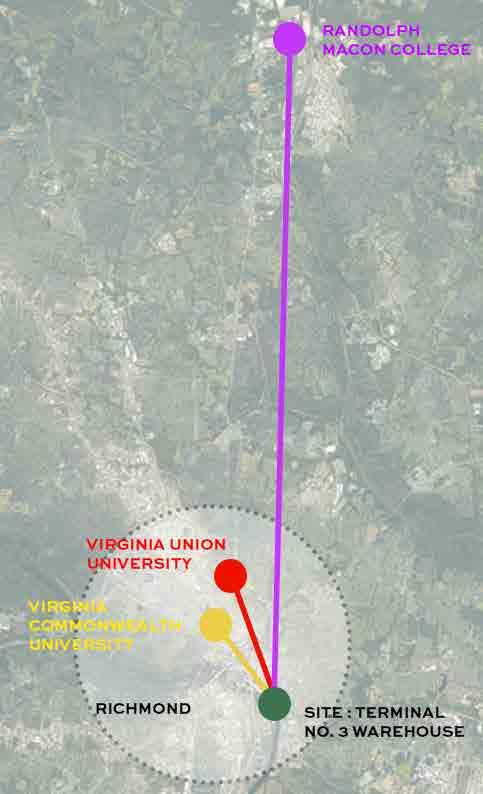



SITE
Richmond Terminal No. 3 Warehouse in Virginia
The origins of Terminal 3 Warehouse can be traced back to the early 20th century when Richmond was a bustling hub of industry and transportation. As railways expanded across the country, Richmond emerged as a crucial railroad center, serving as a key junction for the transportation of goods and passengers along the East Coast.
Terminal 3 Warehouse was constructed in the early 1900s as part of Richmond’s growing network of industrial facilities and transportation infrastructure. Its location near the James River and the downtown area made it an ideal site for storing and transferring goods between railways, river transport, and later, trucking.
Throughout the early to mid-20th century, Terminal 3 Warehouse played a pivotal role in supporting the region’s economy, serving as a distribution center for a wide range of products including agricultural goods, manufactured goods, and raw materials. The warehouse’s proximity to the Richmond Deep water Terminal facilitated the movement of goods between rail, river, and ocean-going vessels, further enhancing its
Following the war, Richmond underwent significant changes as the economy shifted away from heavy industry towards services and technology. While the role of Terminal 3 Warehouse in maritime commerce declined with the rise of containerized shipping and changes in transportation logistics, it continued to serve as a distribution center and storage facility for a variety of goods.
In recent years, there has been renewed interest in redeveloping and re-purposing industrial sites like Terminal 3 Warehouse to meet the evolving needs of Richmond’s economy. Efforts to revitalize the area around the warehouse have included mixed-use developments, adaptive reuse projects, and investments in transportation infrastructure.
Today, the Richmond Terminal 3 Warehouse stands as a reminder of the city’s industrial past and its ongoing transformation into a modern urban center. Its historic significance, combined with its strategic location and potential for redevelopment, ensures that it will continue to play a role in shaping the future of Richmond and the

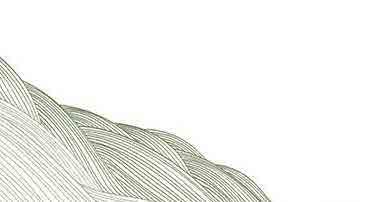



HISTORY


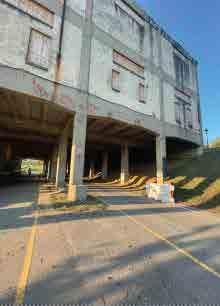

Existing Materials Study







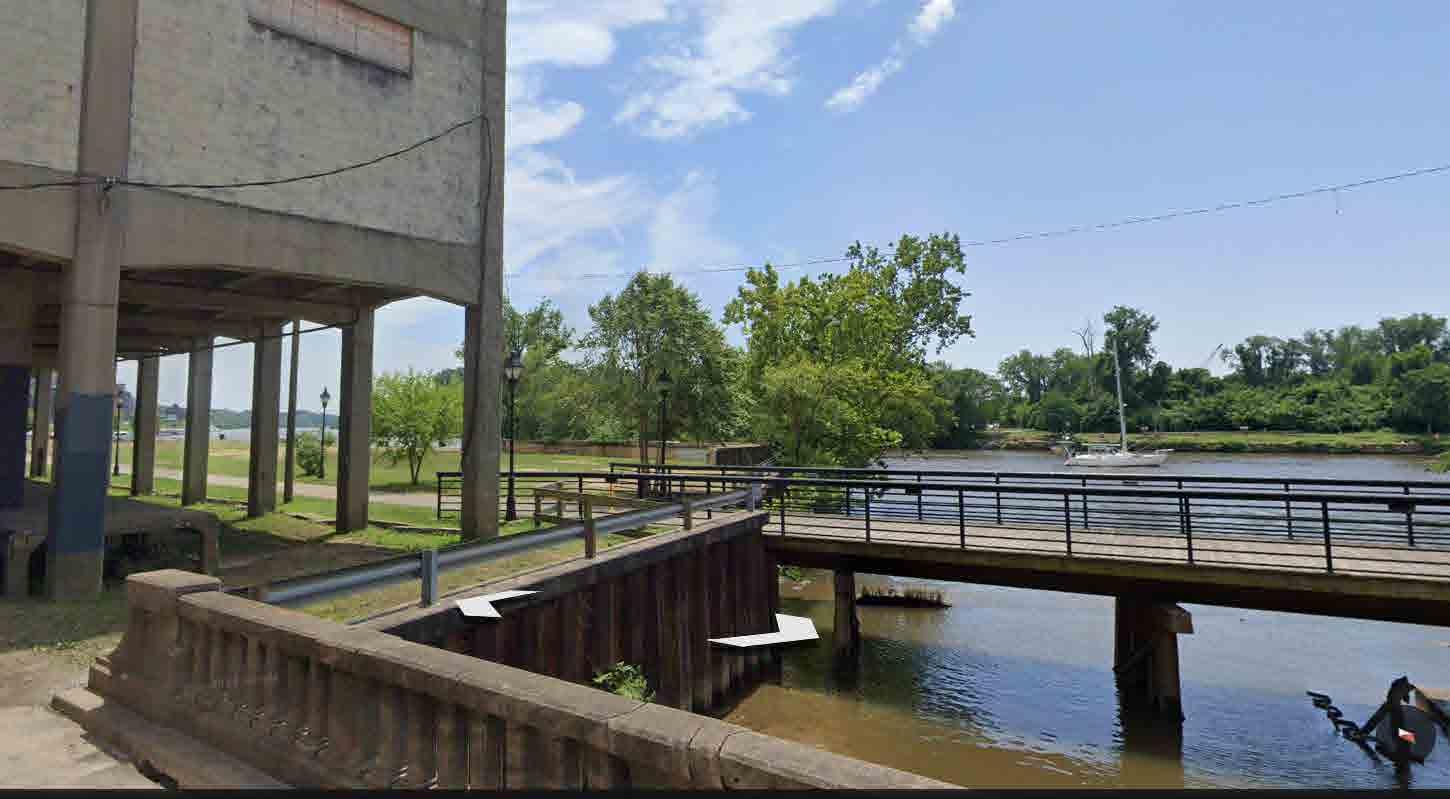
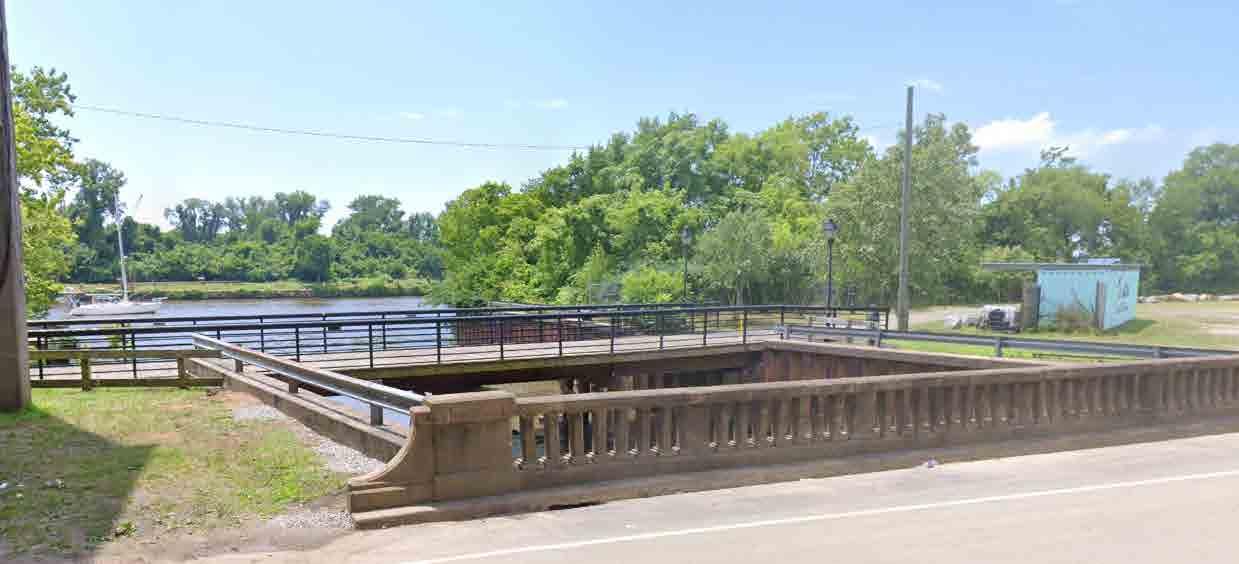

Pros :
- Large & Open Exterior Space
- Proximity to Natural Elements
- Isolated Area for future building developments
-Good amount of sunlight throughout the day
Cons :
- Large & Heavy Concrete Empty Shell
- Little to no windows
- Strict existing column grid
- Long travel distance to parking and access points
- Lack of ADA accessibility
13 ANALYSIS
Concrete Grass Metal River water




CONCEPTUAL DRAWING
14 CASE STUDIES
The arena’s location just north of the Kibbie Dome solidifies the athletics district and creates a landmark architectural public gateway to the campus.



https://www.opsisarch.com/project/idaho-central-credit-union-arena/
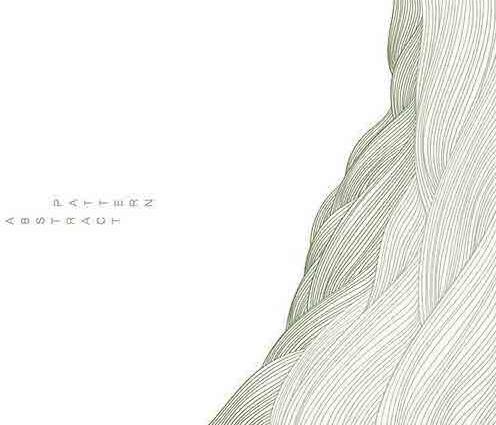

CONCEPT MODEL CONCEPT INSPIRATION RENDERING
Melbourne
Celebrating the natural verdant landscape of its locale, Studio Tate created a collection of immersive spaces with circular architectural form at Relinque, to support an intuitive client journey, offering an ‘all gender’ day spa experience, with an inherently natural feeling palette. A functional floor plan underpins a day spa on one side ice and steam contrast therapy, hydrotherapy, body and face treatment spaces and yoga studio-offering holistic wellness. On the other side, a spinal clinic pilates and osteopathy complete the circular client journey with a natural flow as they move through the space. The functionality component was also key to enabling staff to work efficiently and support the client experience.
A palette of greens, greys, burgundy and earth tones feature through the collective space, reflecting a sense of textural ‘earthiness’ whilst also being contemporary and sophisticated. A concrete floor in reception with coloured aggregate is offset by a forest green marble desk, forest green joinery and leather banquette seating, set against a backdrop of textured paint with timber battens. Within the spa, the five individually contained treatment rooms feature a color datum in a deep rust tone and steam showers tiled in a soft, sage green, with a granite shower bench.
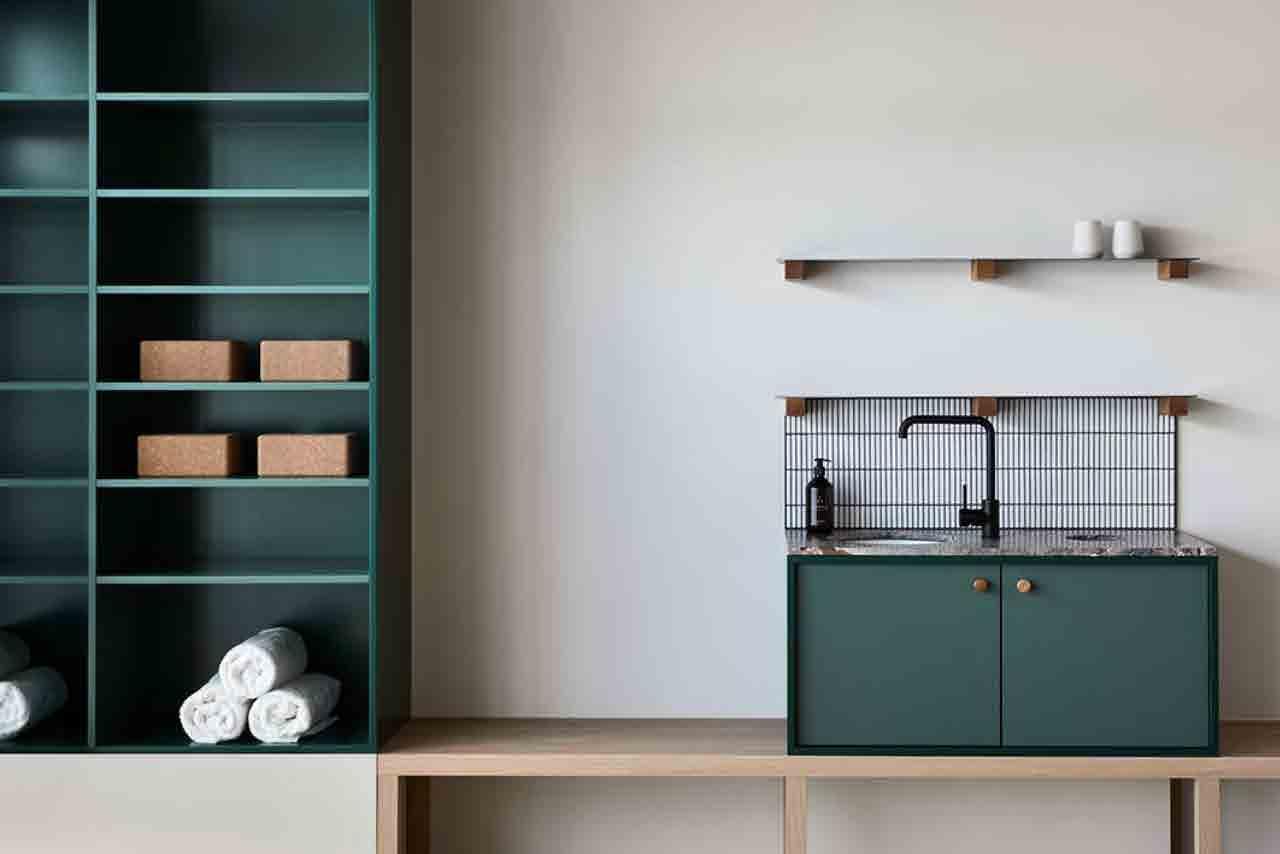
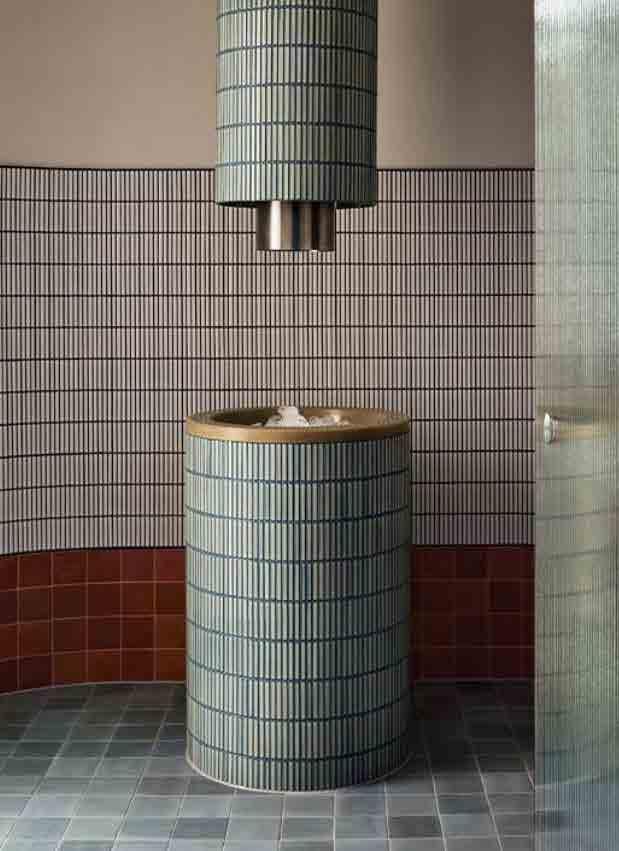

https://www.studiotate.com.au/relinque-wellness-melbourne/



CASE STUDIES
Relinque Wellness
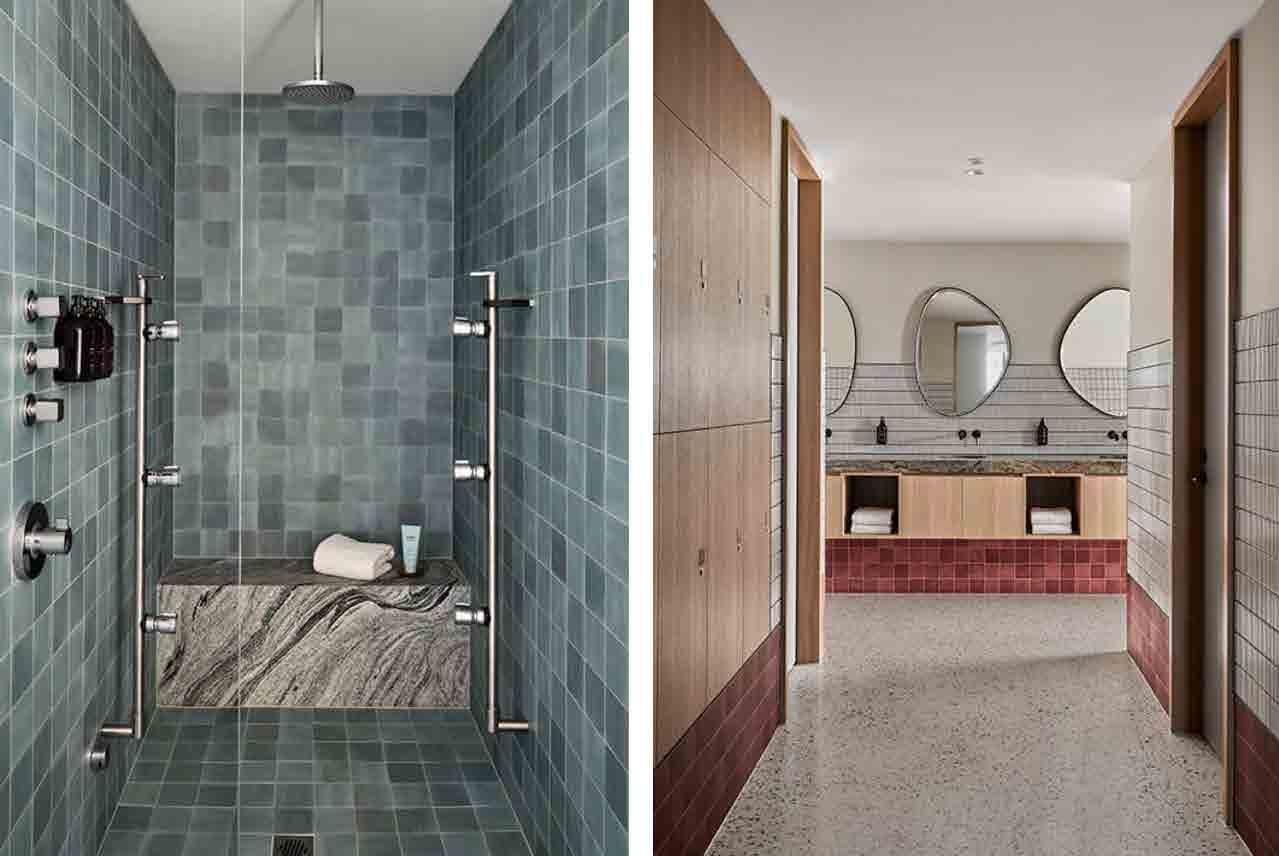
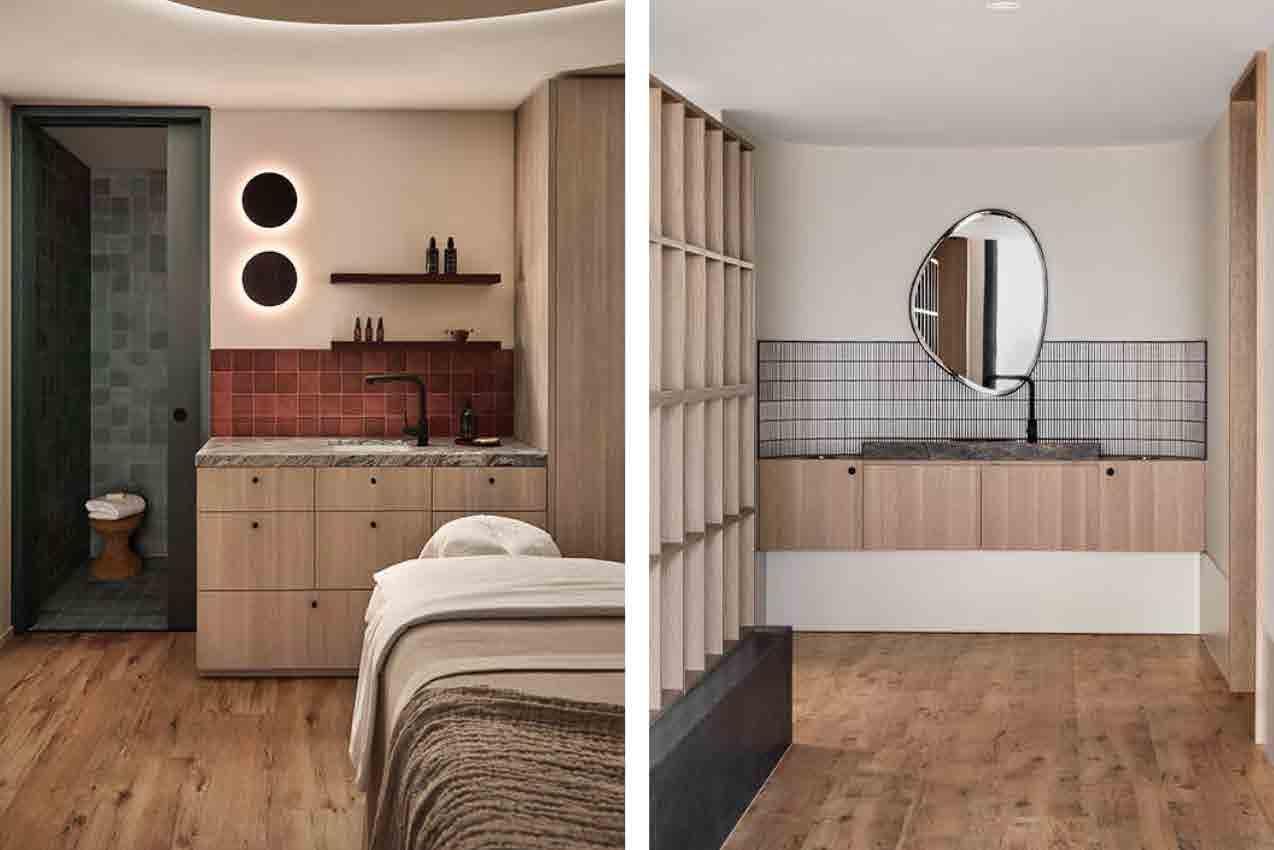




17


The Sanya Wellness Retreat is located in Haitang bay on Hainan Island, a popular resort destination in China. Neri&Hu’s design is inspired by the ancient Chinese walled city, elevated on a heavy plinth, it is usually surrounded by water for protection. As such the hotel is defined by two parts, the wooden dwelling comprising guest rooms perches atop a masonry base that contains all the public spaces below.
Two L-shaped building volumes come together to form a water courtyard, the central feature from which all the hotel’s public amenities spread and emanate outwards. The lobby becomes a garden landscape with a floating lantern hovering above that allows a gentle light to filter in, and with the soft breeze that flows through, guests are immediately transported to a relaxed state of mind for appreciating the slow pace of island life. At the same time, the ceilings here are lowered and suppressed in order to simultaneously frame views outward to the azure seas beyond.





18 CASE STUDIES
Sanya Wellness Retreat
For the guest rooms, each unit is conceived as an individual wooden hut that contains functional amenities such as the washrooms. In the negative space between the wooden boxes lies the sleeping and relaxing zones, including the ocean view balconies. The alternating rhythm between solid and void, the angled walls and textured material expression, all contribute to a dynamic facade that is constantly playing with light and shadow. The corridor between the bedroom units becomes an urban streetscape, an alley where people can traverse and enjoy chance encounters, as such are the delights of being a traveler.
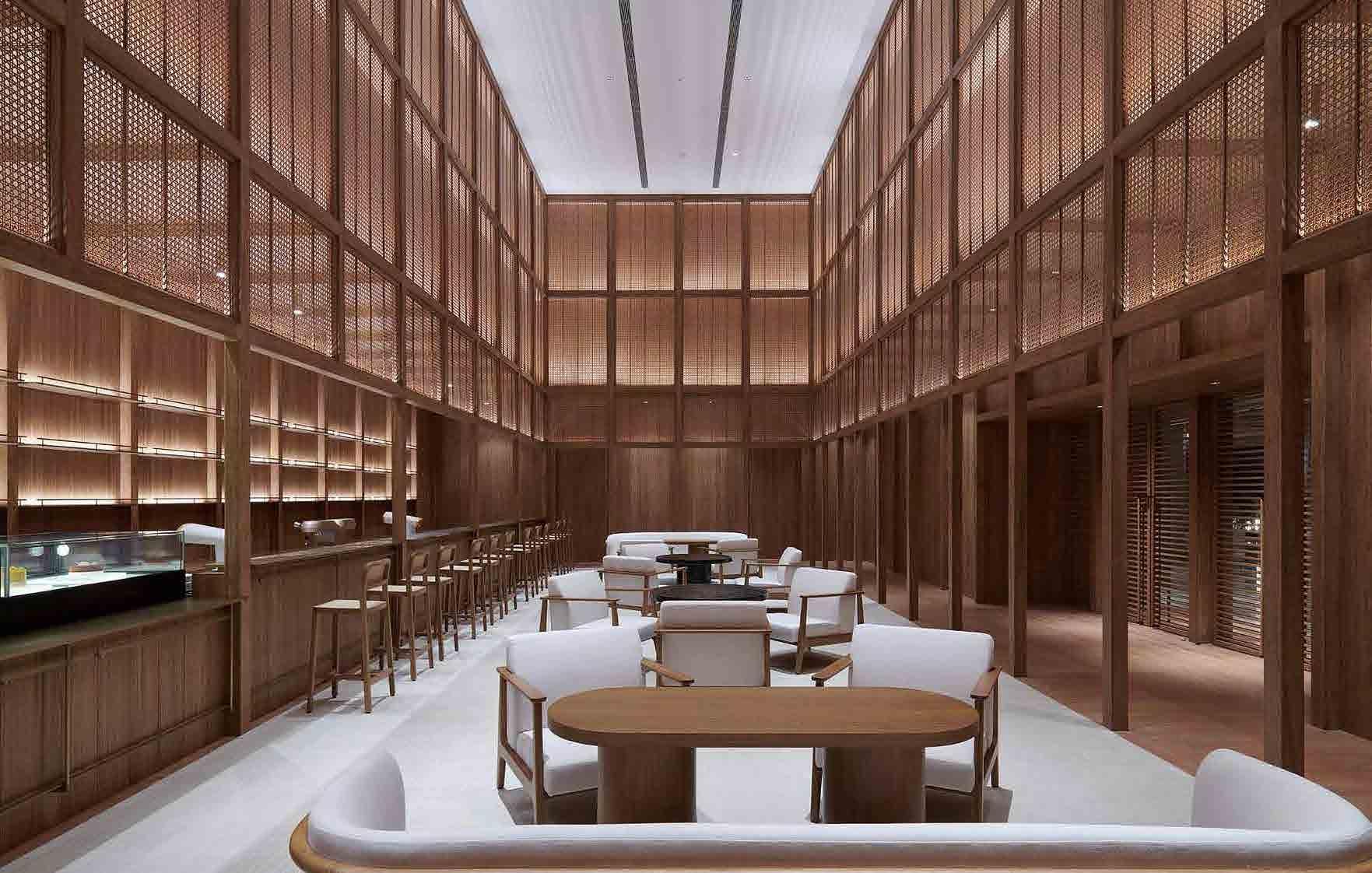


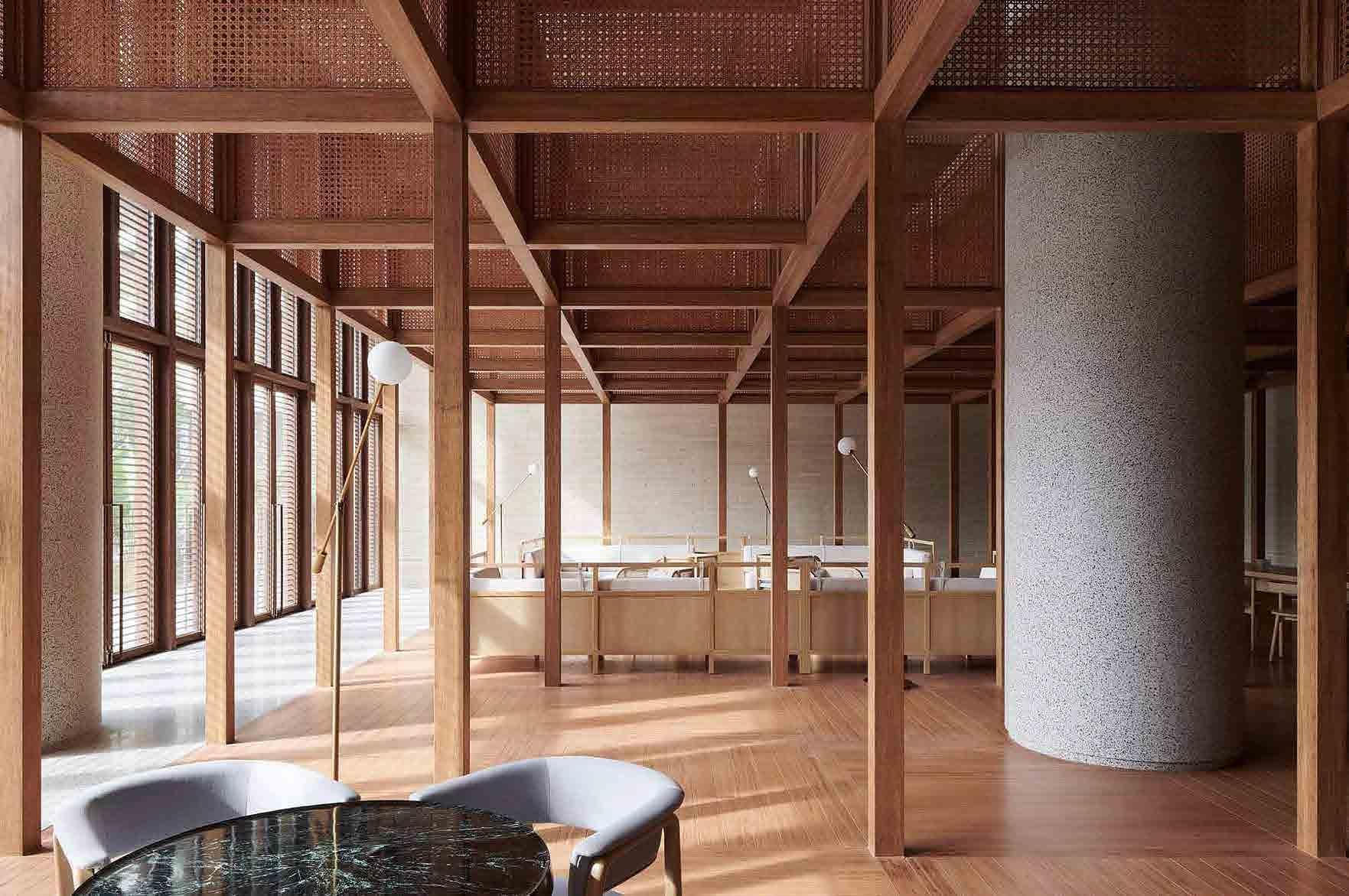
At every given opportunity, the design tries to embody the genius loci of Hainan, to blend elements from the island’s collective memory, culture and natural features. Tapping into local craftsmanship, the masonry walls which envelop the lower levels are clad with handmade clay bricks, while the fabrics and rugs are inspired by textile arts of the Li minority tribe. The technique of soaking and pressing bamboo is also employed as a building material, with woven rattan and yellow bronze accents to enhance the layers to the project.
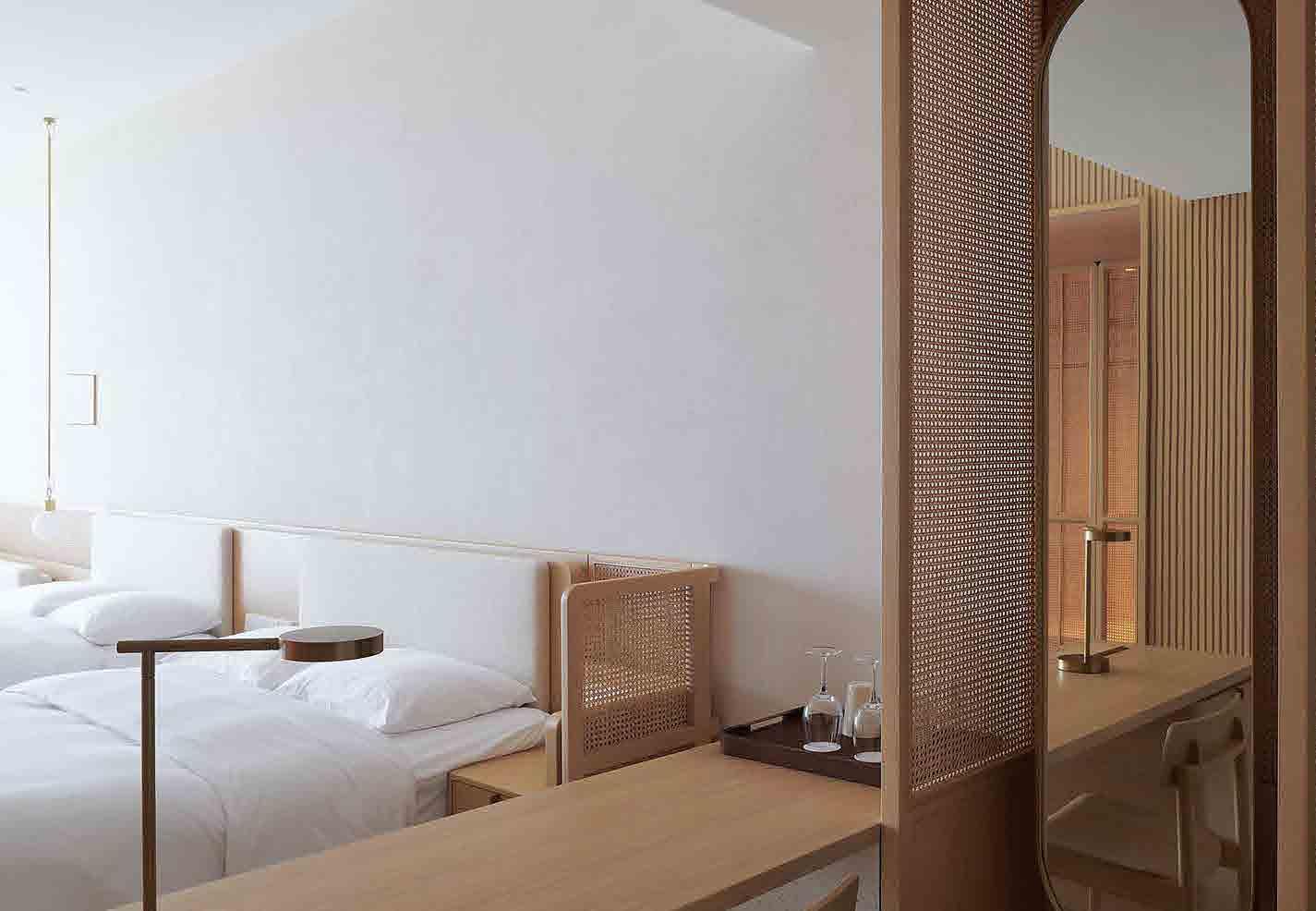
https://www.neriandhu.com/en/ works/walled-city-sanya-wellness-retreat_4




19
Chakras are energy centers within the body, originating from ancient Indian spiritual traditions. There are seven main chakras aligned along the spine, each associated with specific organs, emotions, and spiritual qualities. These energy wheels are believed to govern physical, emotional, and spiritual well-being. When the chakras are balanced and aligned, energy flows freely throughout the body, promoting health and vitality. However, blockages or imbalances in these energy centers can lead to physical ailments or emotional disturbances. Practices like yoga, meditation, and energy healing aim to harmonize and activate the chakras, fostering holistic well-being and spiritual growth.

Root Chakra : Safety, Security, Strong foundation
Sacral Chakra : Feelings and Creativity
Solar Plexus Chakra : Confidence and Willpower
Heart Chakra : Love and Connection with others
Throat Chakra : Self Expression
Third Eye Chakra : Intuition and Imagination.
Crown Chakra : Spirituality, Knowledge, Acceptance

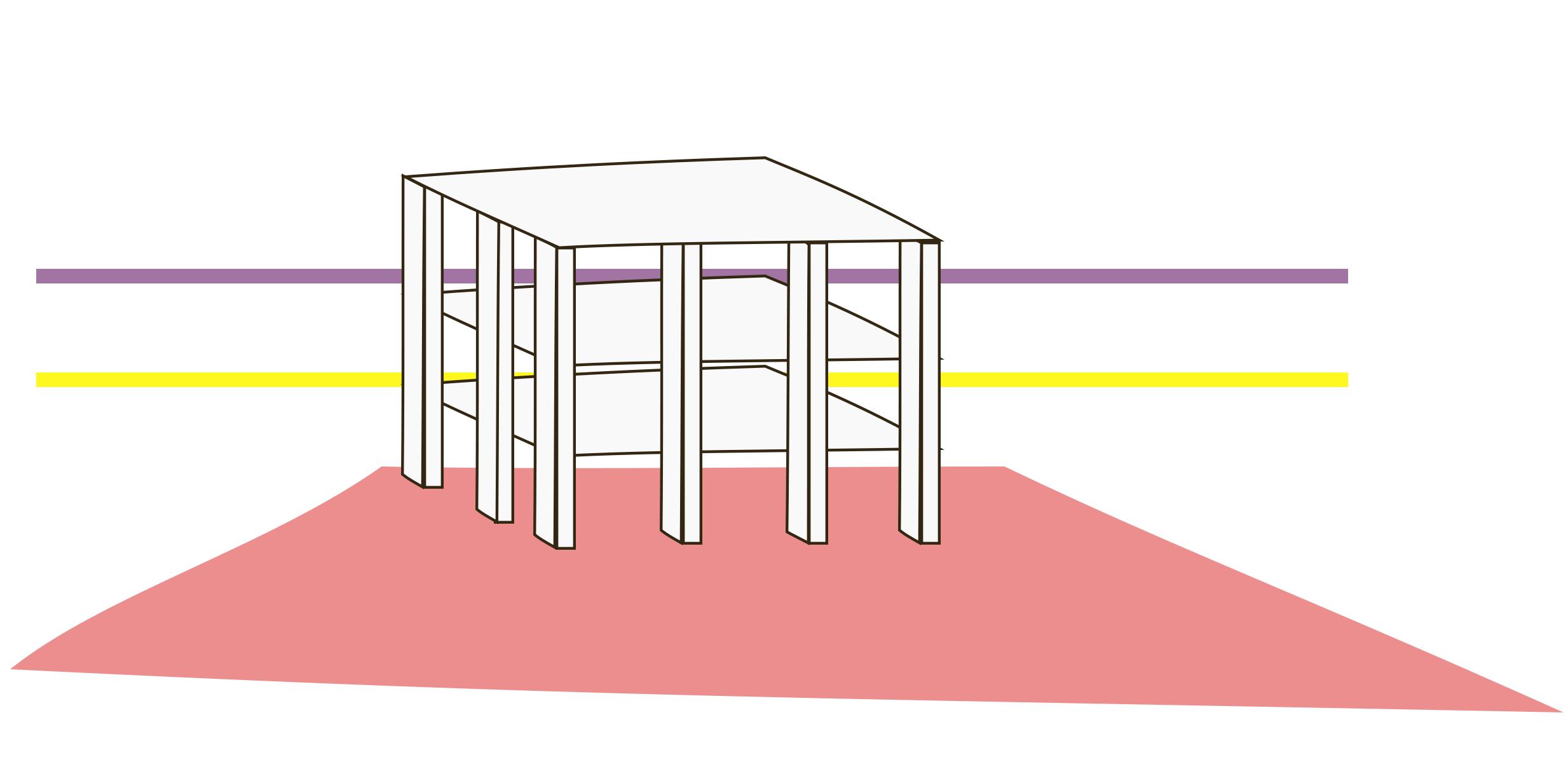
Application of Chakra Locations to Site

CONCEPT
Chakras : Centers of Energy
Crown Chakra
Crown Chakra
Solar Plexus Chakra
Solar Plexus Chakra
Root Chakra
Root Chakra
Vibrations associated with wavelengths can affect...
Chakras are associated with specific colors and wavelengths, reflecting their unique energy frequencies. Each chakra resonates with a particular color that embodies its qualities and functions. For instance, the Root Chakra corresponds to the color red, symbolizing vitality and survival instincts, while the Solar Plexus Chakra is linked to yellow, representing personal power and confidence. Additionally, the Crown Chakra is associated with violet or white, symbolizing spiritual connection and enlightenment. Just as red light has a longer wavelength than yellow light, these colors carry distinct vibrations that influence our emotions and well-being. By recognizing and harmonizing these color associations, individuals can work towards balancing and activating their chakras, fostering inner harmony and holistic health. Chakras are believed to have a significant impact on mood, heart rate, and alertness. When the chakras are balanced and aligned, individuals often experience improved mood, a sense of calm, and emotional stability. This balance can also lead to a regulated heart rate, promoting overall cardiovascular health. Moreover, activated chakras are thought to enhance alertness and mental clarity, allowing individuals to feel more focused and present in their daily activities. Conversely, when the chakras are blocked or imbalanced, it can lead to mood swings increased heart rate, and feelings of lethargy or mental fog.
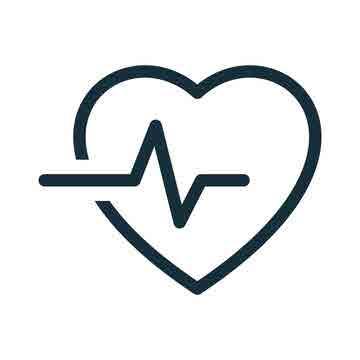







21
ROOT CHAKRA - LOWEST WAVELENGTH
SOLAR PLEXUS CHAKRA - LOWER HALF WAVELENGTH
CROWN CHAKRA - HIGHEST WAVELENGTH
Heart Rate
Mood Alertness


This space is intended as the halfway mark in the user’s path. These places will focus on the user’s action and dedication towards rebuilding their physical state.

This space is intended as the first step in the user’s path. These places will focus on acceptance and knowledge to target the recovery of the user’s mental state.
Element : Space & Time Element : Fire & Light
: Violet & White
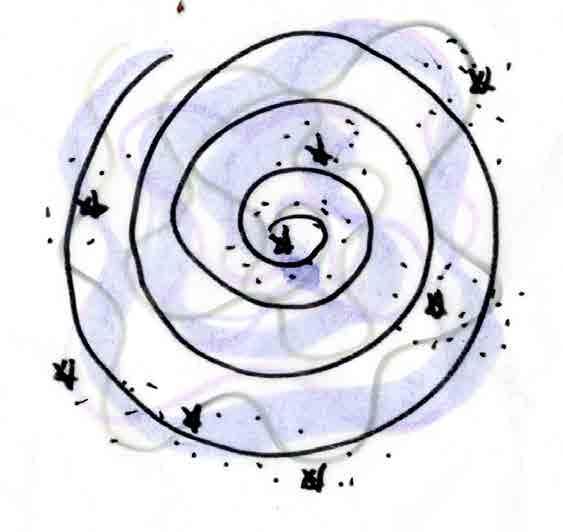


This space is intended as the finish line in a user’s path. These places will showcase the user’s journey and their returning debut to redefine themselves as Athletes.
: Earth
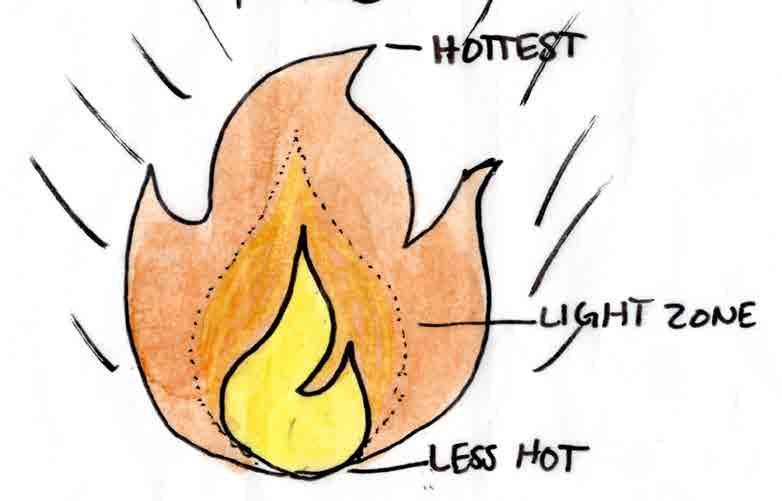

22 CONCEPT
Crown Chakra
Solar Plexus Chakra Root Chakra
do...” “ I am...”
Element
“ I know...” “ I
Color
Color
Sense
Processing
Sense
Sense
Open Free Organic Motion Speed Enlightenment Knowledge Acceptance Space Isolation Private Surrounding
: Light Glass Heat Dancing Sand Unpredictable Growing Layers Natural Actions Building Expanding
Words : Strong Core Rocks Defining Unmoving Plants Hard Levels Natural Earthy Evolving Location
Color
: Yellow
: Red
:
& 6th Sense
: Sight
: Smell Descriptive Words :
Descriptive Words
Descriptive


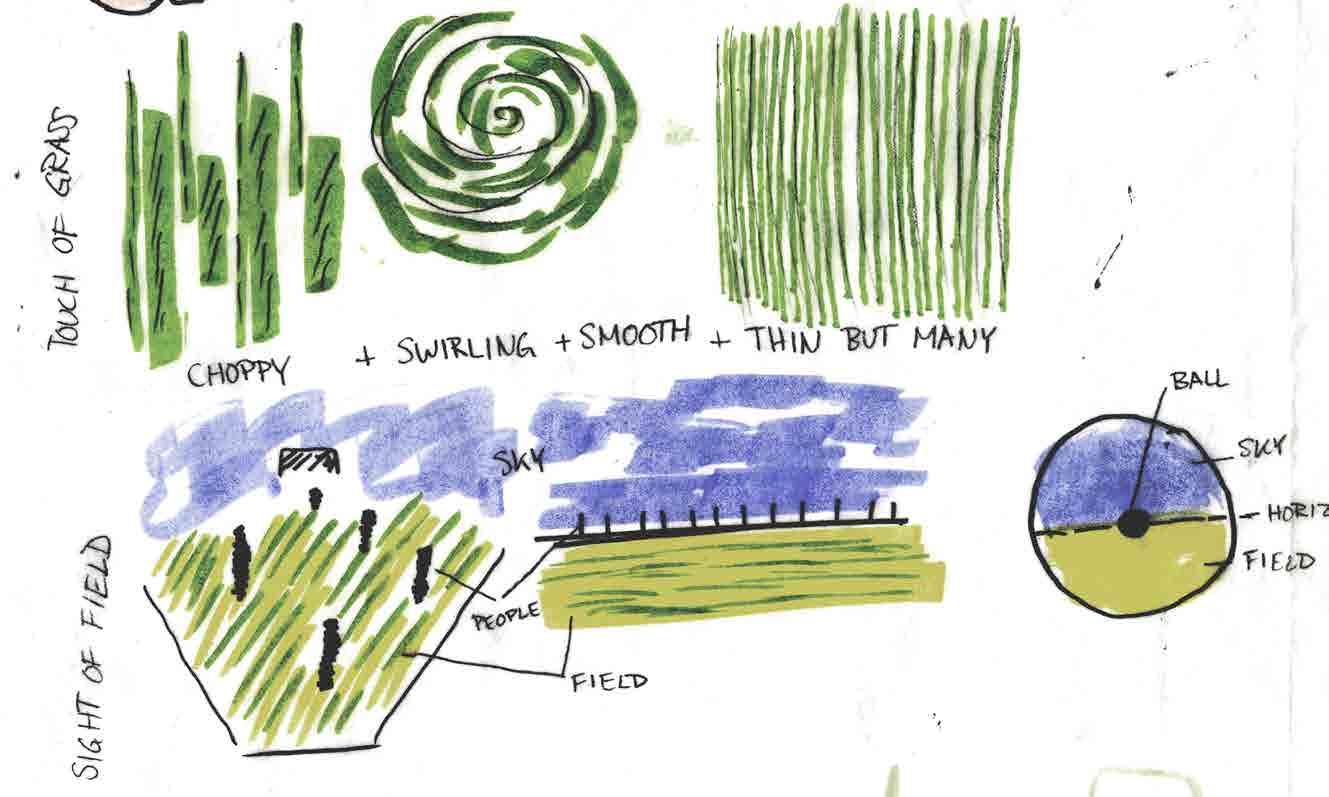

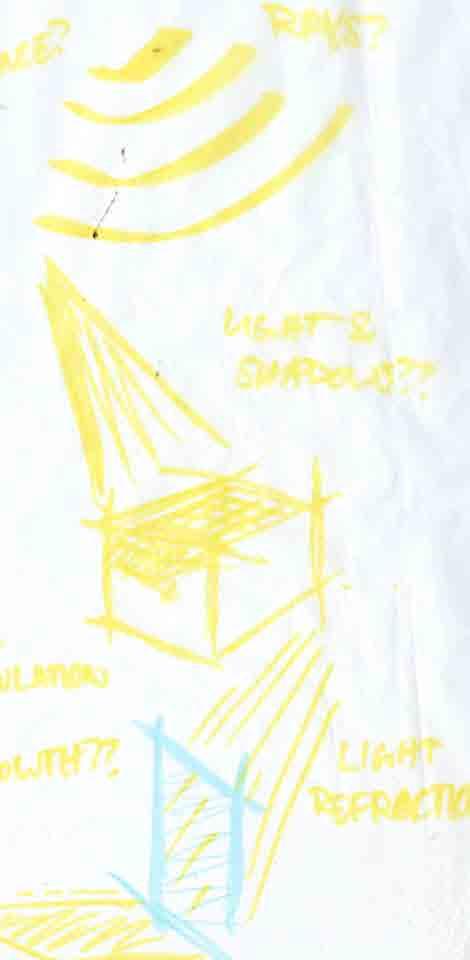




Chakras can be understood in terms of the idea of compression and release, reflecting the flow of energy within the body. When chakras are compressed, it signifies a blockage or imbalance, hindering the free flow of energy and potentially leading to physical or emotional discomfort. Practices such as stress, negative thoughts, or trauma can contribute to this compression. Conversely, when these blockages are released through practices like meditation, yoga, or energy healing, the chakras can expand and realign, allowing energy to flow freely once again. This release often brings about feelings of relaxation, clarity, and well-being as the body and mind return to a state of balance and harmony.


SECOND FLOOR
- RECEPTION
-PATIENT ROOMS
- X RAY ROOM
- MASSAGE ROOMS - SAUNA
- LEARNING & ACCEPTANCE LOUNGE
- REFLECTION GARDEN - INDOOR TRACK

FIRST FLOOR
- RECEPTION -RECREATIONAL COURT -BREAK ROOM -TRAINING STUDIO -TRAINING STUDIO
- TRAINING ROOM - LOCKER ROOMS -TRAINING POOL -LOBBY

EXTERIOR SPACE -SPORTS FIELD -MINI COURTS
PROJECT SQUARE FOOTAGE & OCCUPANCY
- 30,000 BUILDING SQ FT IN TOTAL - 6,000 SQ FT FOR CIRCULATION (20%) -24,000 SQ FT REMAINING FOR PROGRAM
-16,800 SQ FT ASSEMBLY GROUP A (56%) -7,200 SQ FT BUSINESS GROUP B (24%)
- 5,000 ROOF SQ FT USED
- 70,000 EXTERIOR SQ FT USED
TOTAL PROJECT SQ FT : 105,000 SQ FT
APPROXIMATE MAX. OCCUPANCY : 408

PROGRAM
24% BUSINESS GROUP
B PROGRAMMING
20% CIRCULATION
Low Priority
Secondary Priority
Primary Priority
PROGRAM - # NUMBER OF ROOMS
Plumbing Needed:
- FIRST FLOOR RECEPTION/ CAFE
- BREAKROOM
- LOCKER ROOMS
- TRAINING POOL
- PATIENT ROOMS
- SAUNA

BREAK ROOM
FIRST FLOOR RECEPTION/CAFE LOBBY
RECREATIONAL COURT
LOCKER ROOMS
TRAINING STUDIO
TRAINING ROOM
TRAINING POOL
REFLECTION GARDEN

SPORTS FIELD
SECOND FLOOR RECEPTION
PATIENT ROOMS X RAY ROOM
MASSAGE ROOMS SAUNA
MINI COURTS
INDOOR TRACK
LEARNING & ACCEPTANCE LOUNGE
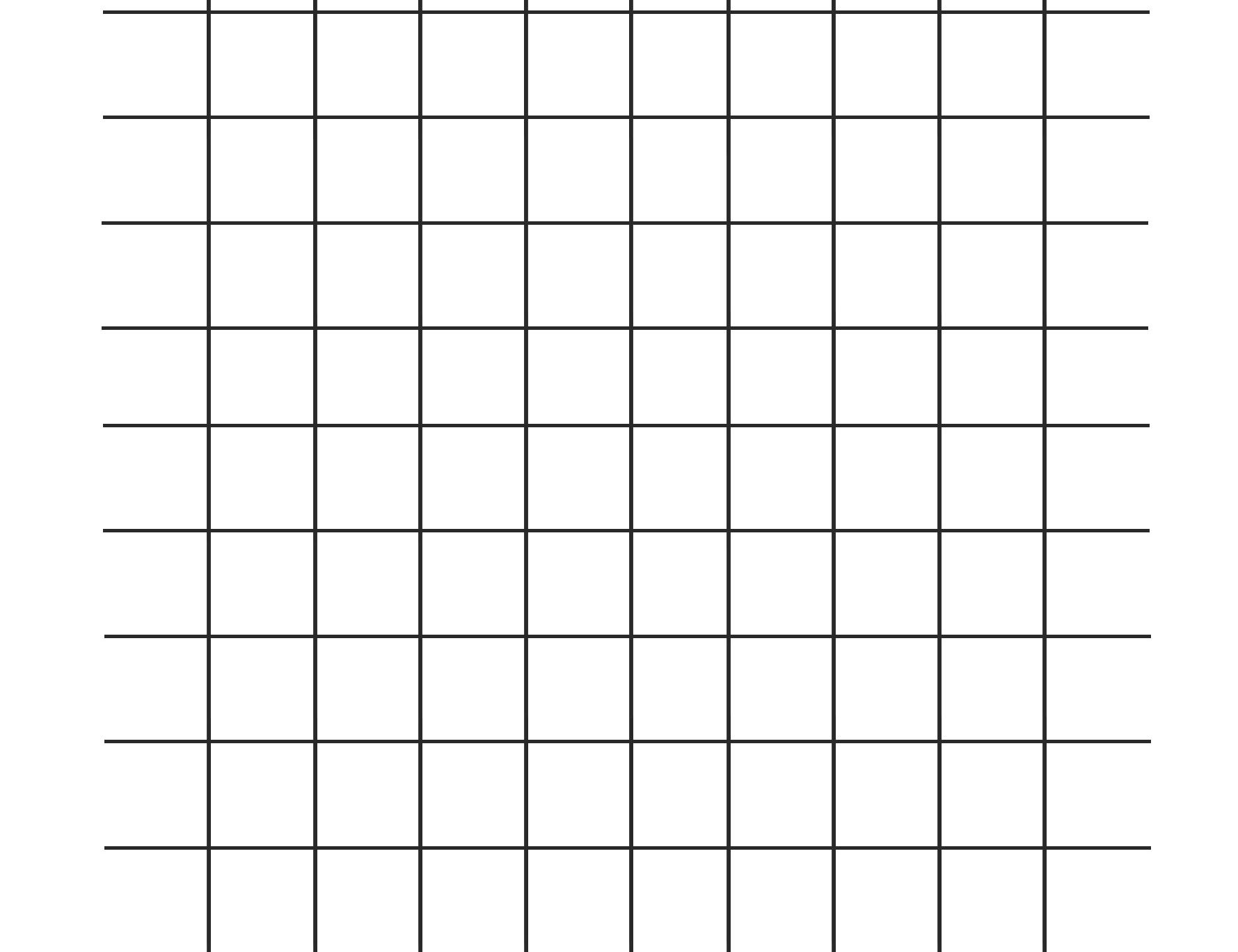
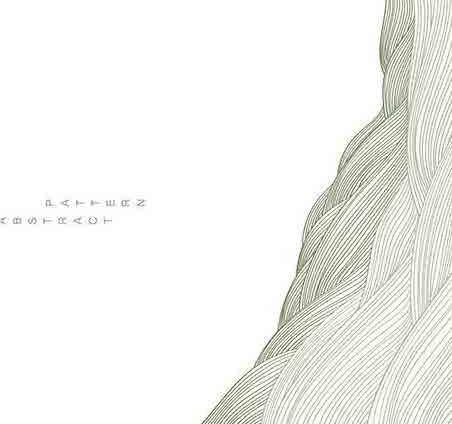
Adjacency Matrix
BREAK ROOM FIRST FLOOR RECEPTION/CAFE
RECREATIONAL COURT
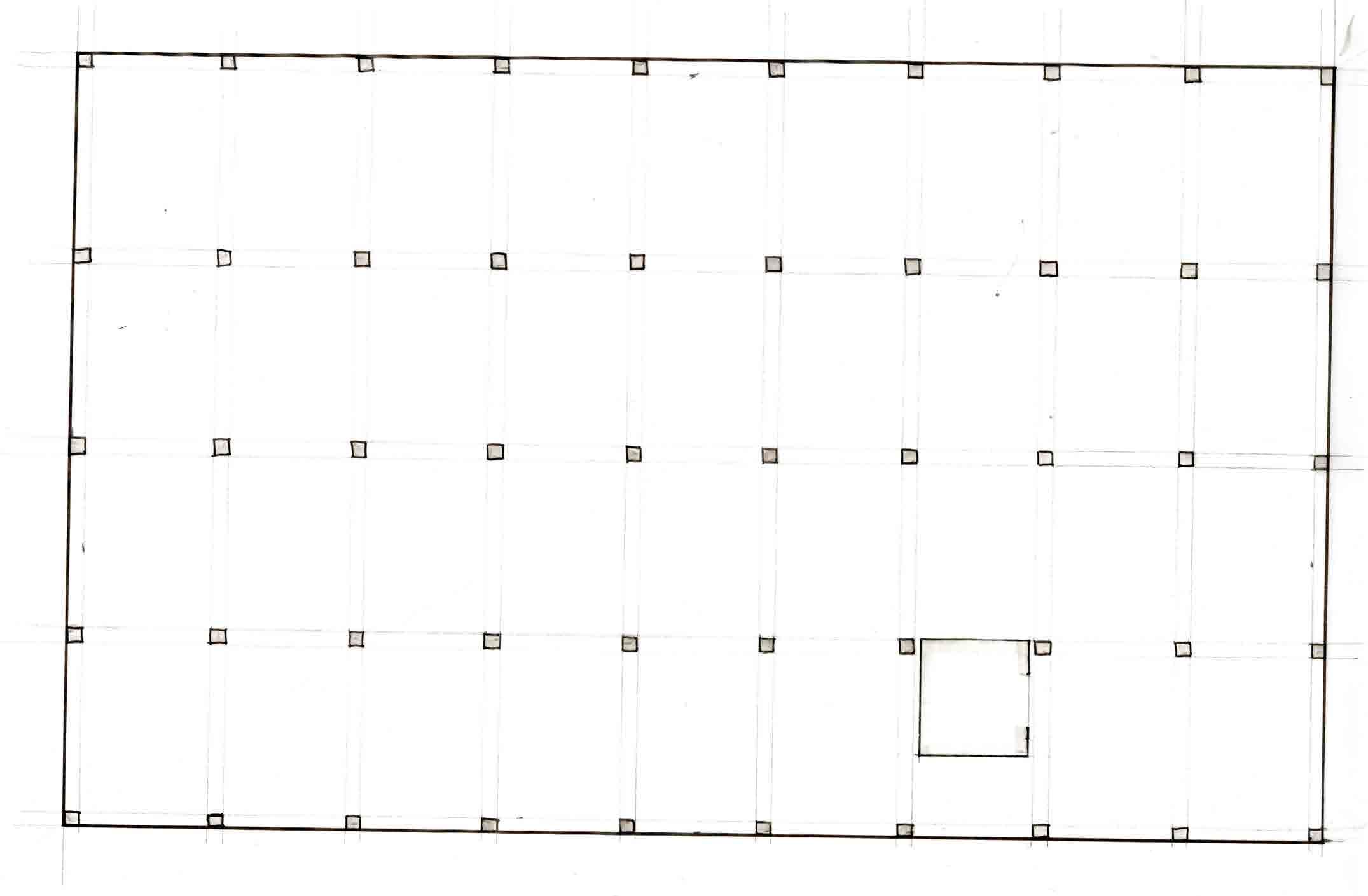
TRAINING ROOM

LOCKERS
RECREATIONAL COURT
TRAINING ROOM
LOCKERS
STUDIO STUDIO
RECEPTION/ LOBBY
RECEPTION/ LOBBY


LOCKERS
RECEPTION/ LOBBY
TRAINING ROOM
STUDIO
RECREATIONAL COURT
TRAINING ROOM

STUDIO
RECREATIONAL COURT
RECEPTION/ LOBBY
26 SCHEMATICS
LOCKERS
POOL POOL POOL BREAK BREAK BREAK BREAK FIRST
FLOOR

RECEPTION/ LOBBY

RECEPTION/ LOBBY

SECOND FLOOR


RECEPTION/ LOBBY
27 TRACK
X RAY MASSAGE SAUNA PATIENT TRACK TRACK TRACK POOL POOL PATIENT RECEPTION/
X RAY SAUNA MASSAGE POOL X RAY
LOBBY
SAUNA MASSAGE PATIENT
PATIENT MASSAGE X RAY
POOL
SAUNA





28 SCHEMATICS SECTION BUBBLES STUDYING VOLUME




VISUAL CONNECTIONS BETWEEN FLOORS


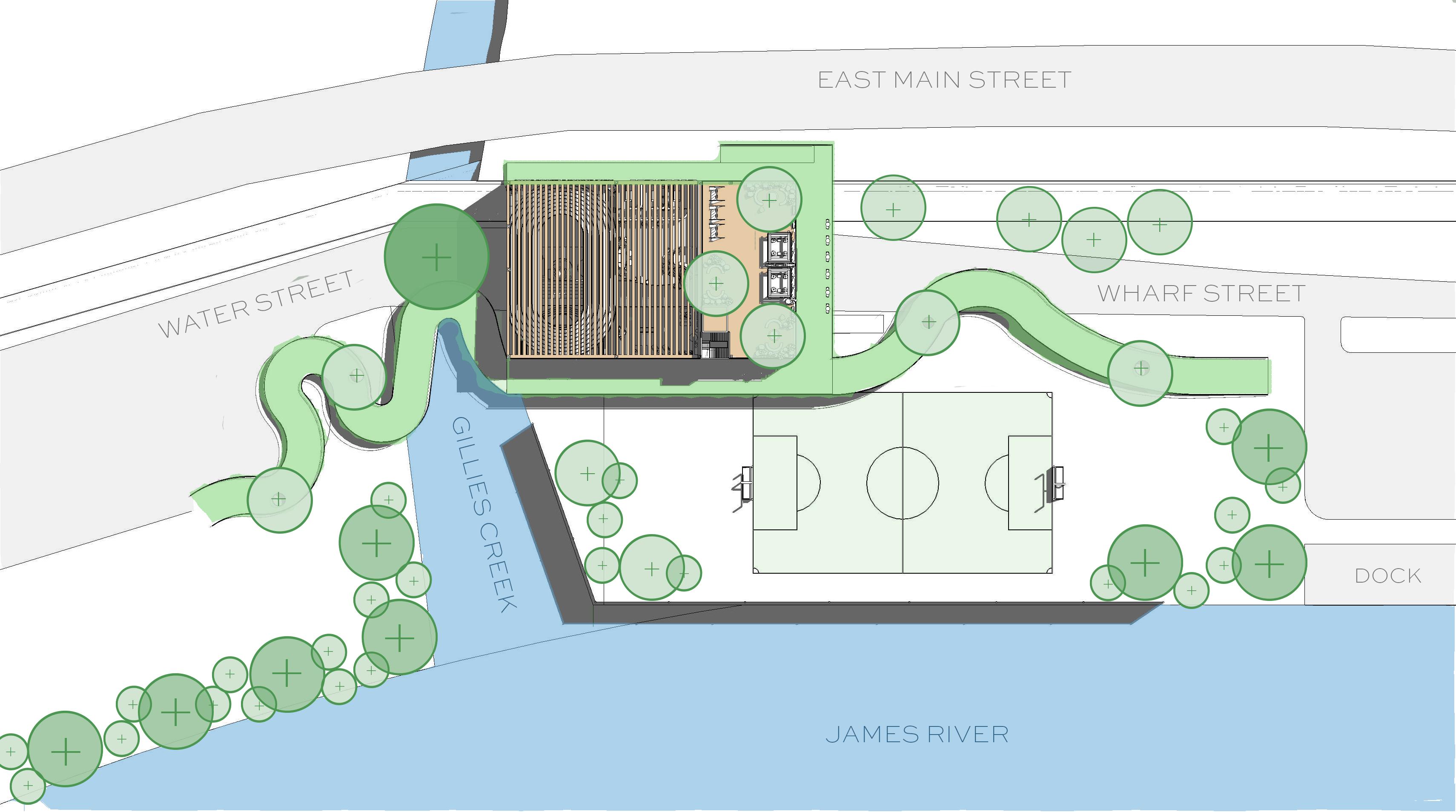
SCHEMATICS
SCALE : 1/64” = 1’-0”
SOUTH EAST EXTERIOR ELEVATION
SCALE : 1/16” = 1’-0”
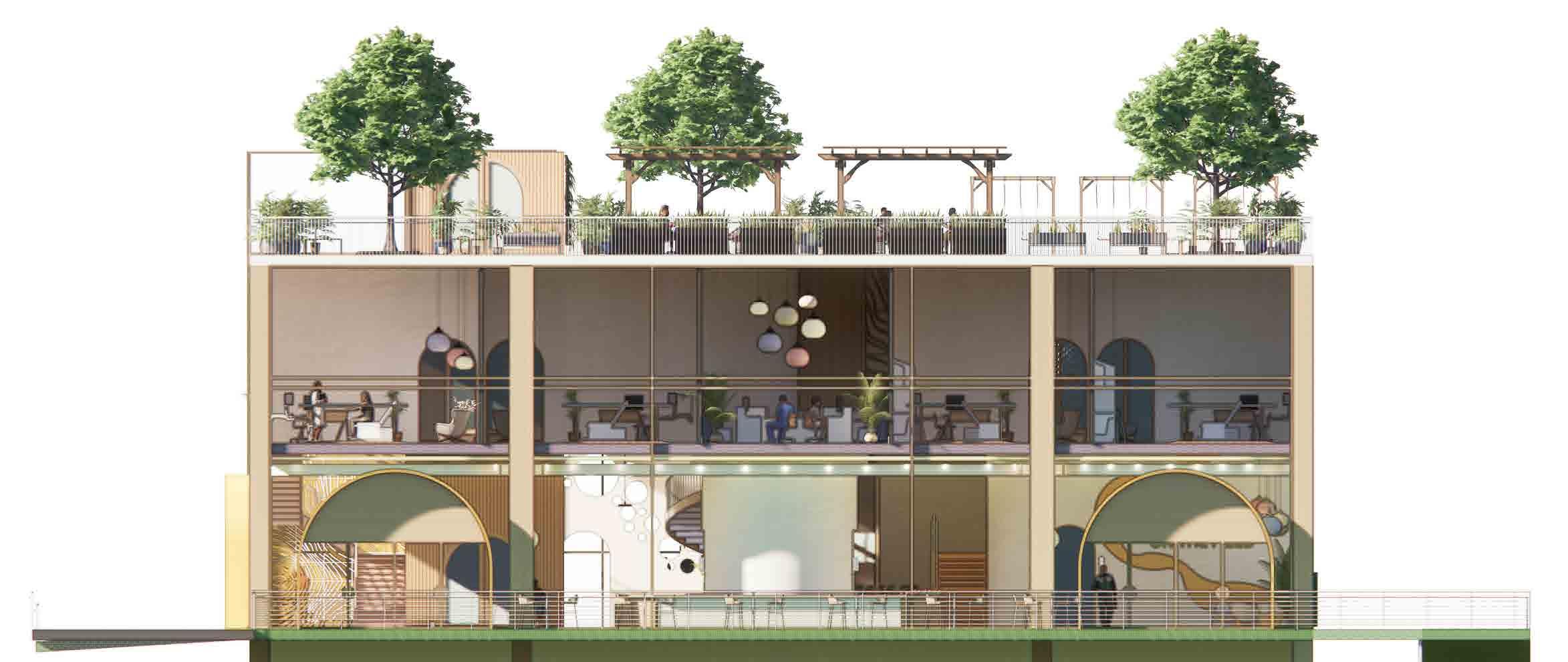
SITE 3D RENDERING

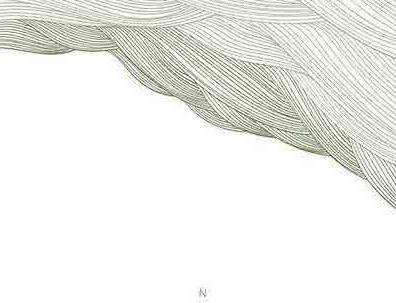
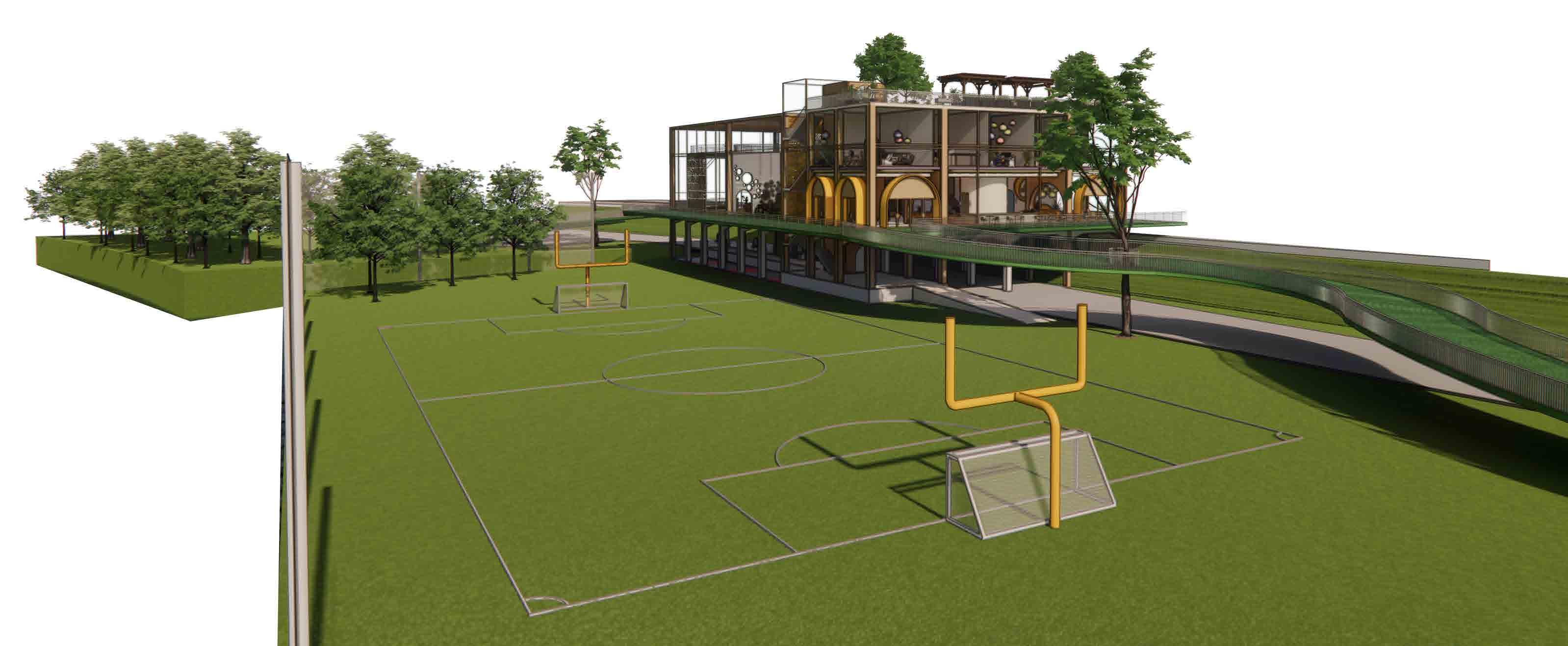



NORTH

SCALE : 1/16” = 1’-0”
SCHEMATICS


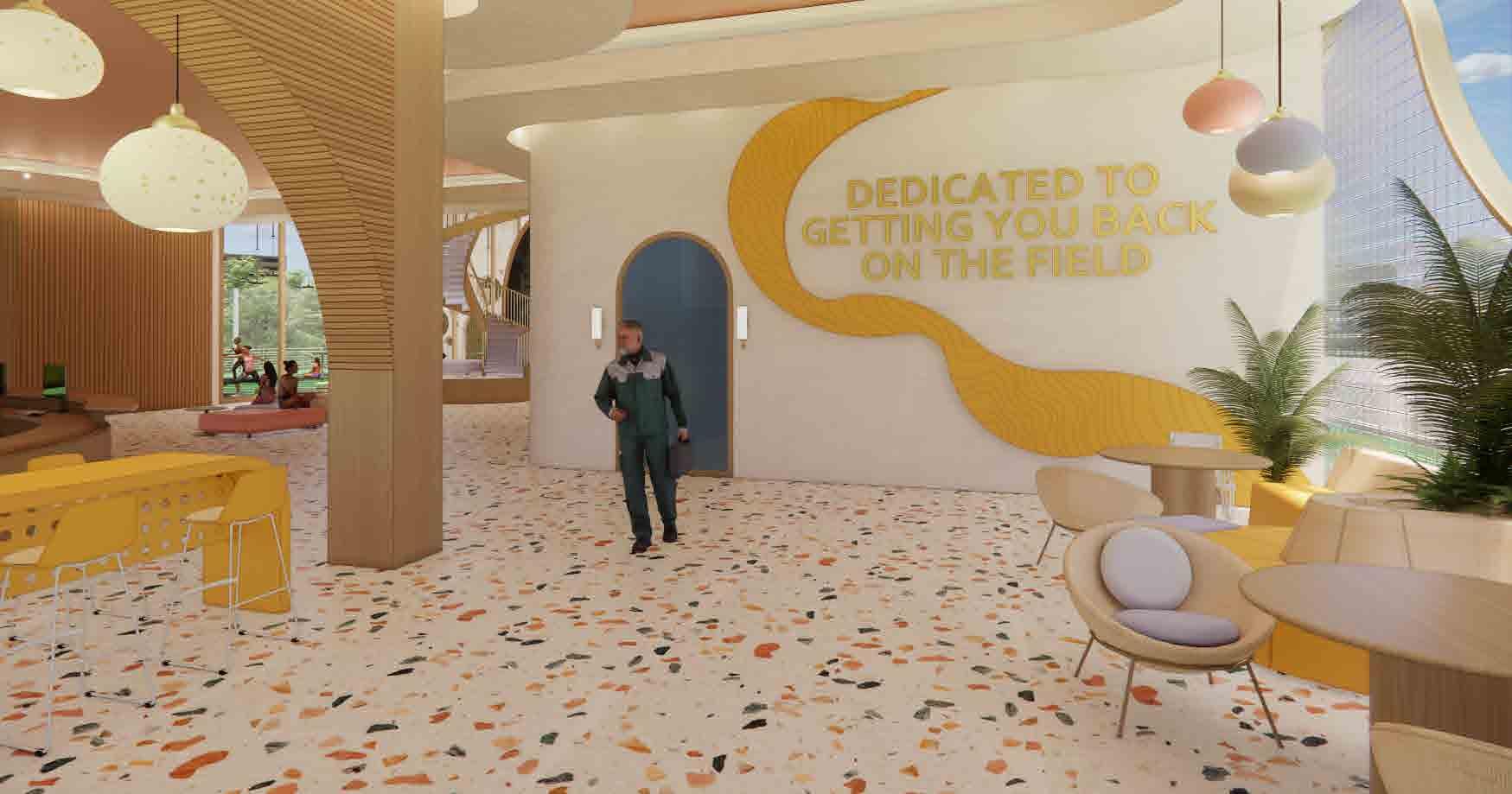

SEATING AREA

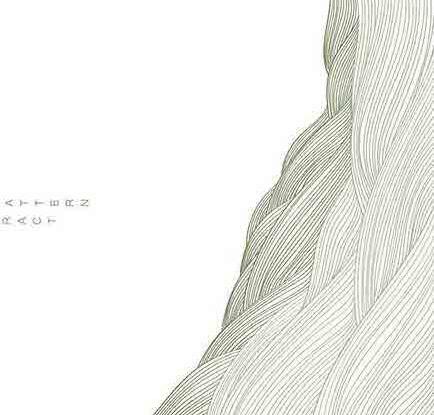
FIRST FLOOR 3D AXON RENDERING
LOBBY
ENTRANCE
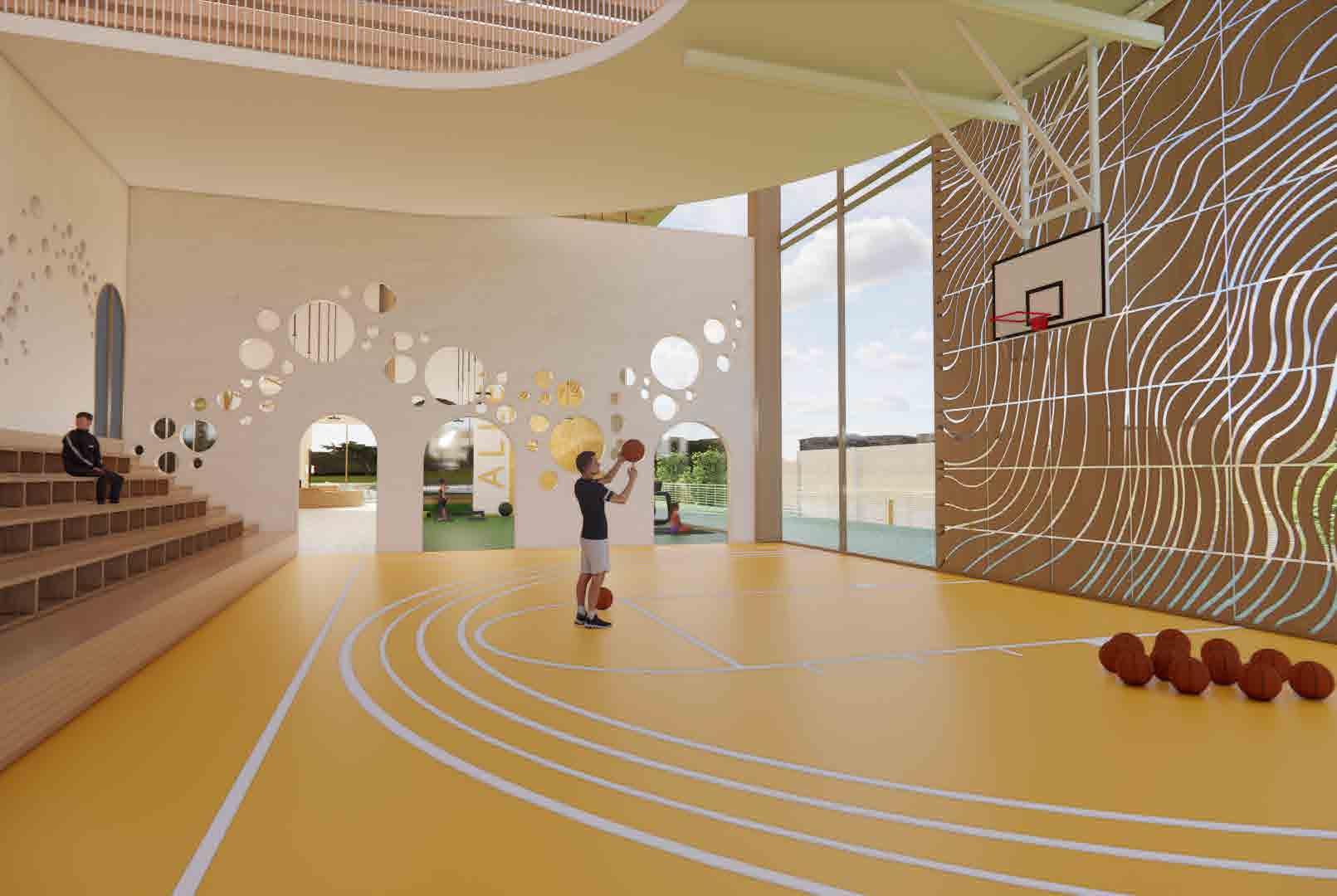


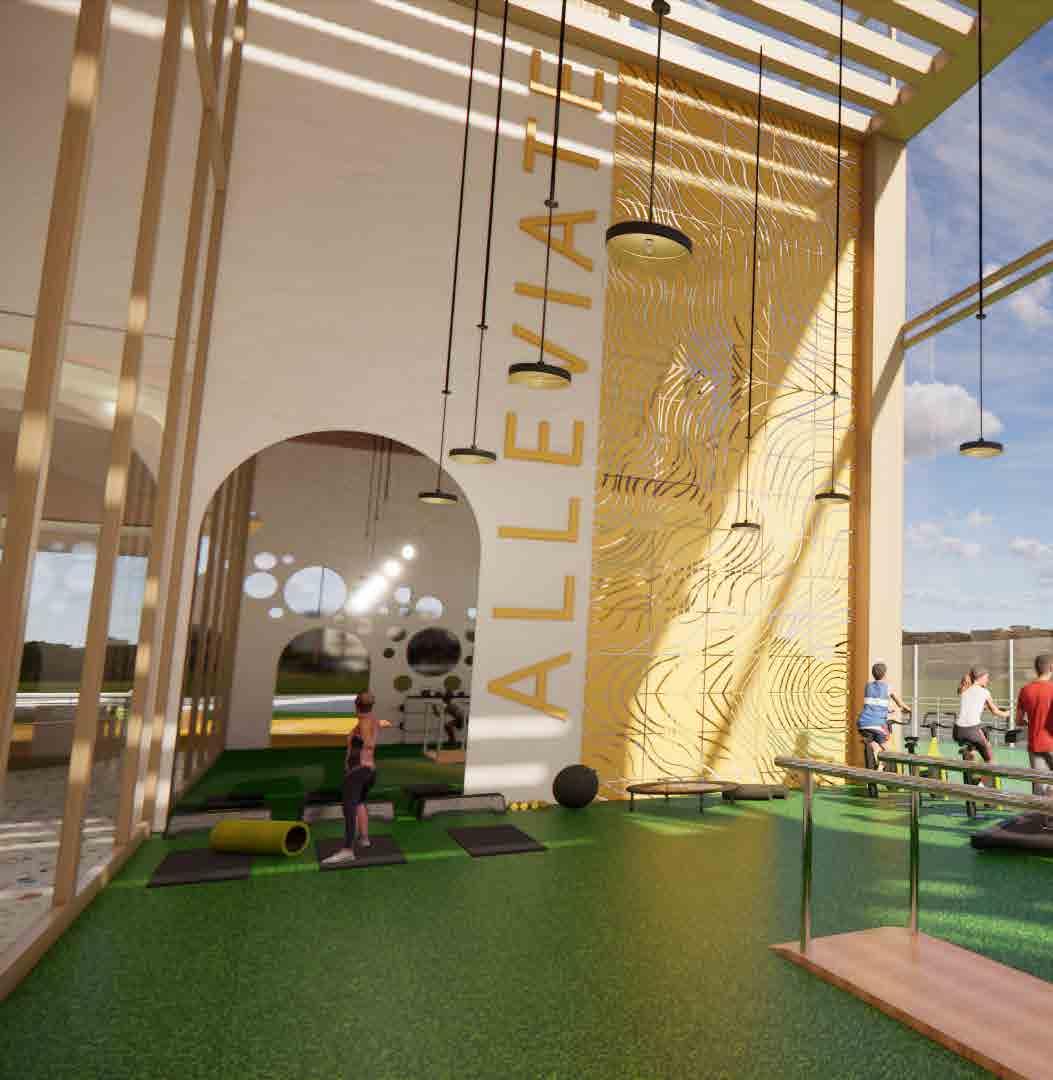
34 SCHEMATICS
SOUTH WEST EXTERIOR ELEVATION SCALE : 1/16” = 1’-0”
RECREATIONAL COURT
TRAINING ROOM

TRAINING SPACE SECTION NOT TO SCALE


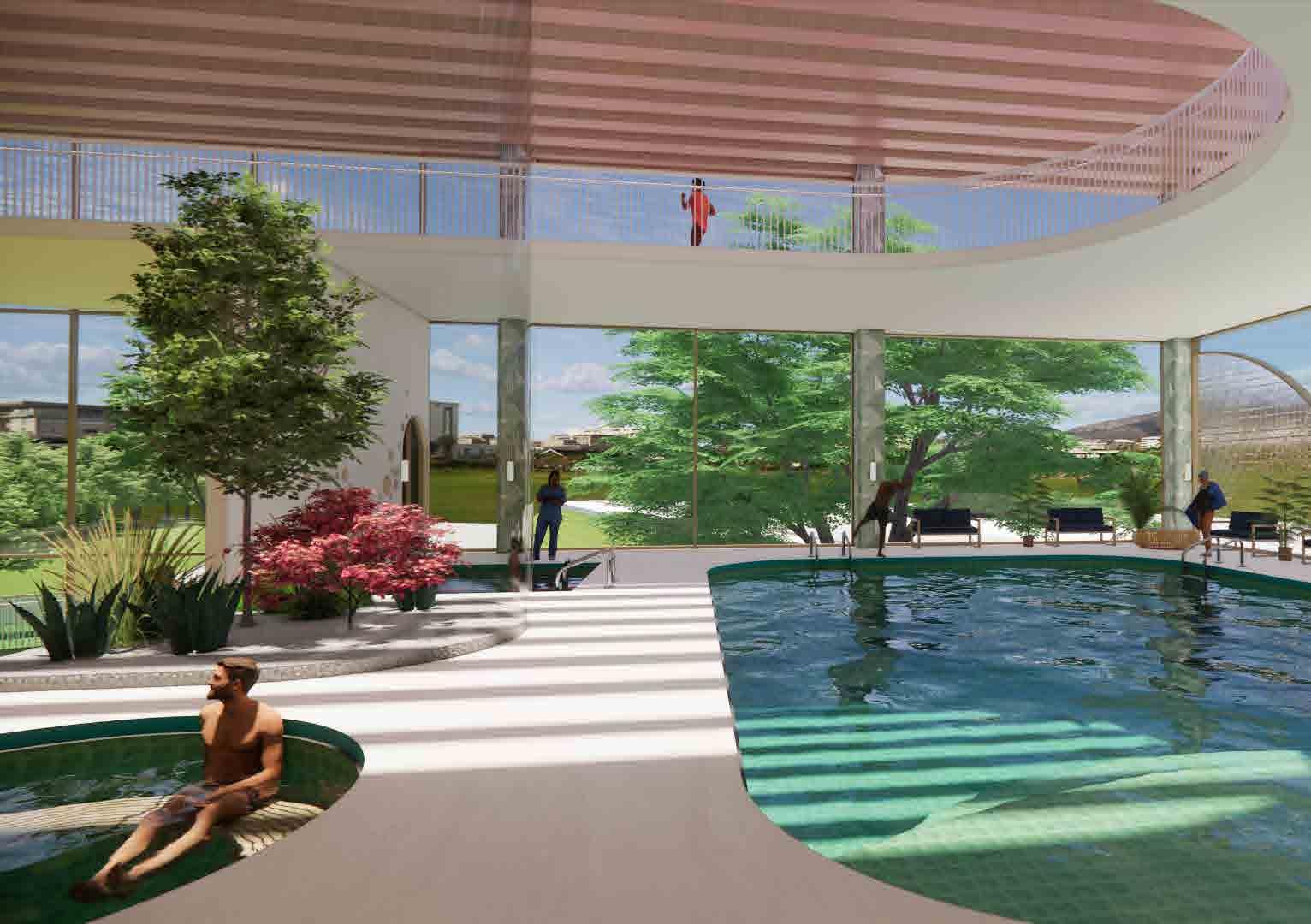


STUDIO



SCHEMATICS
SCALE : 1/16” = 1’-0”




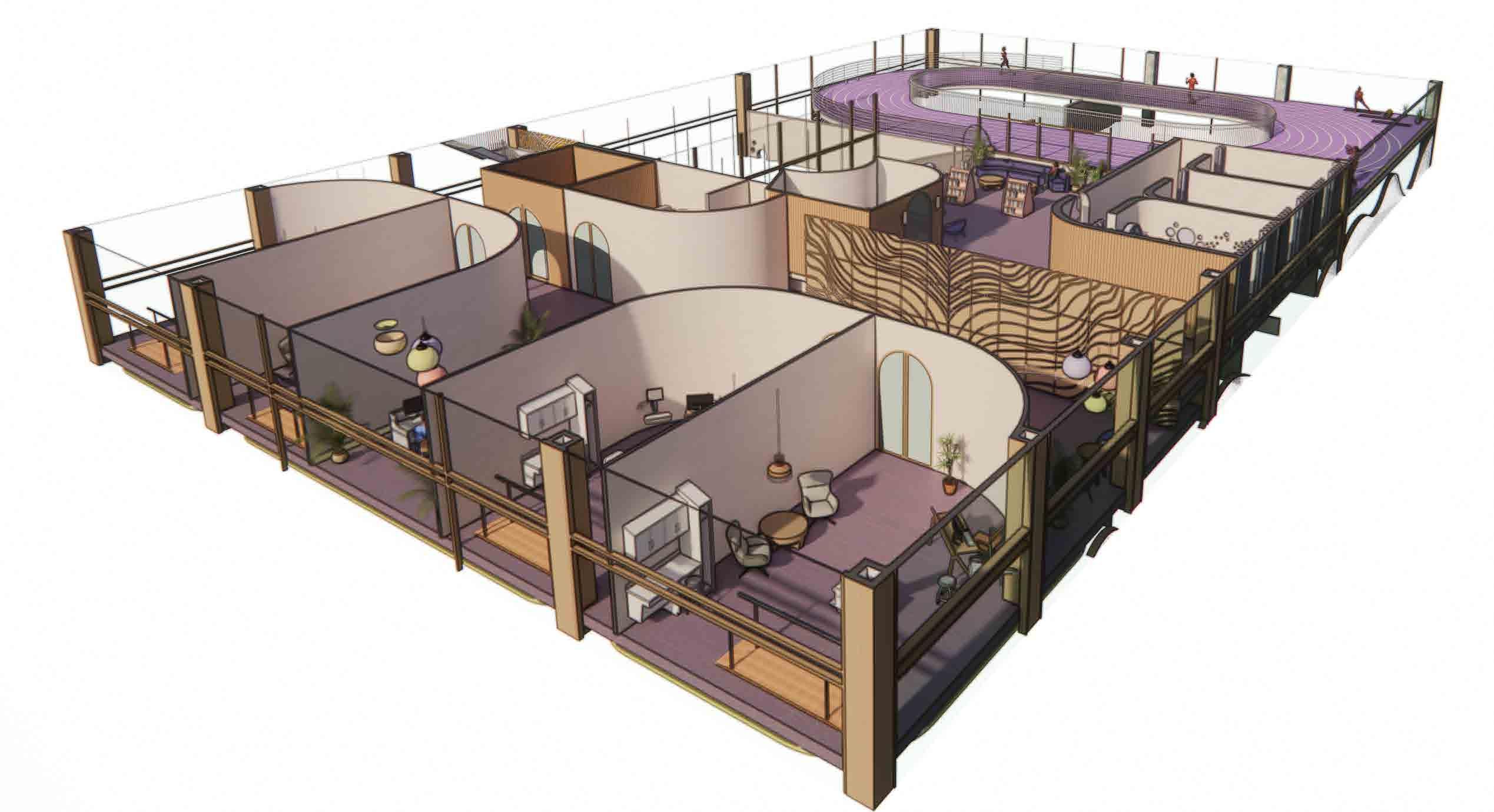 SECOND FLOOR LOBBY
SECOND FLOOR 3D AXON RENDERING
SECOND FLOOR RECEPTION
SECOND FLOOR LOBBY
SECOND FLOOR 3D AXON RENDERING
SECOND FLOOR RECEPTION



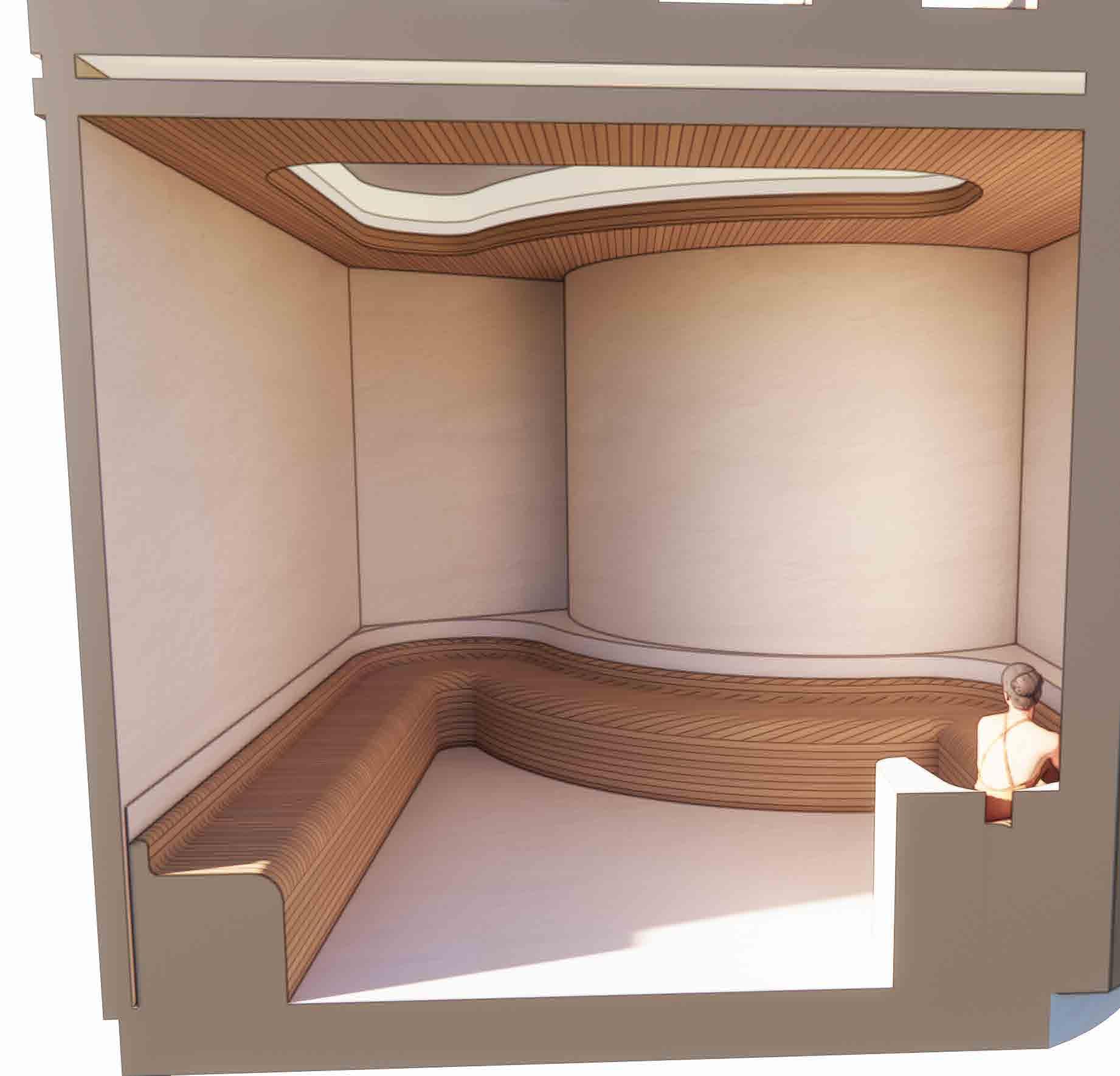


SCHEMATICS
SAUNA SECTION PRESPECTIVE
TRACK RESTING AREA
TRACK
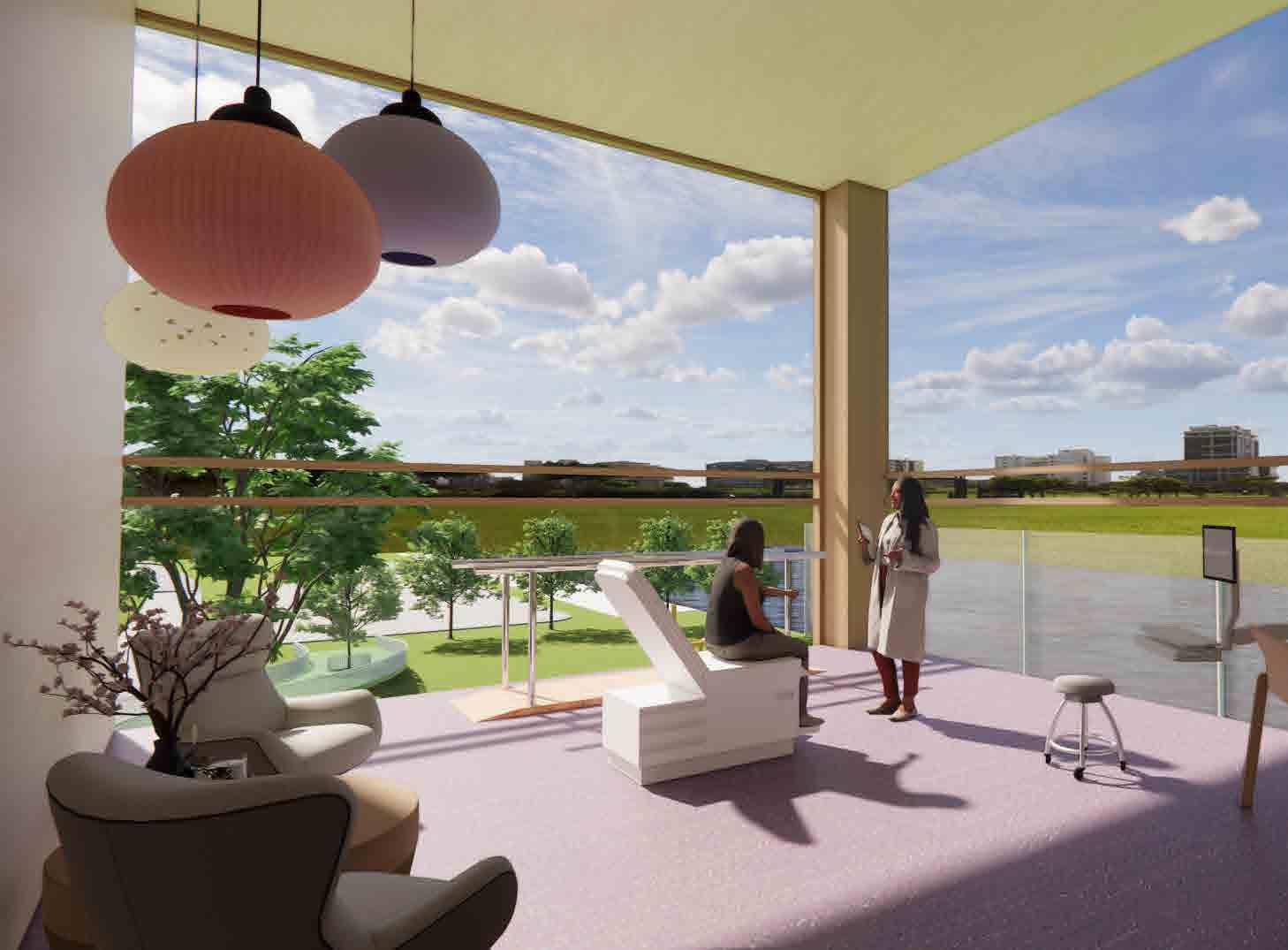




LEARNING & ACCEPTANCE LOUNGE SEATING AREA
PATIENT ROOM

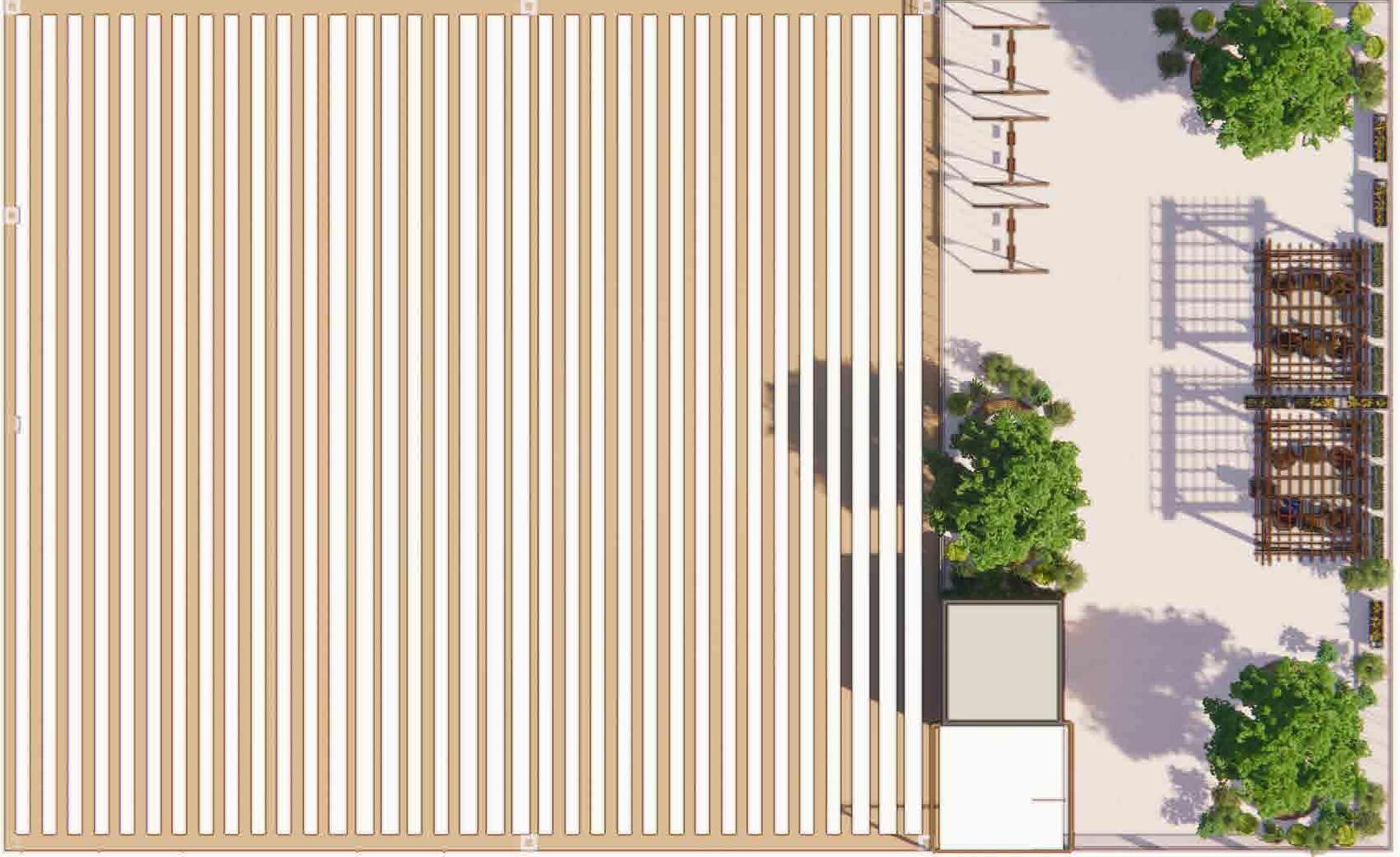

SCHEMATICS
SCALE : 1/16” = 1’-0”
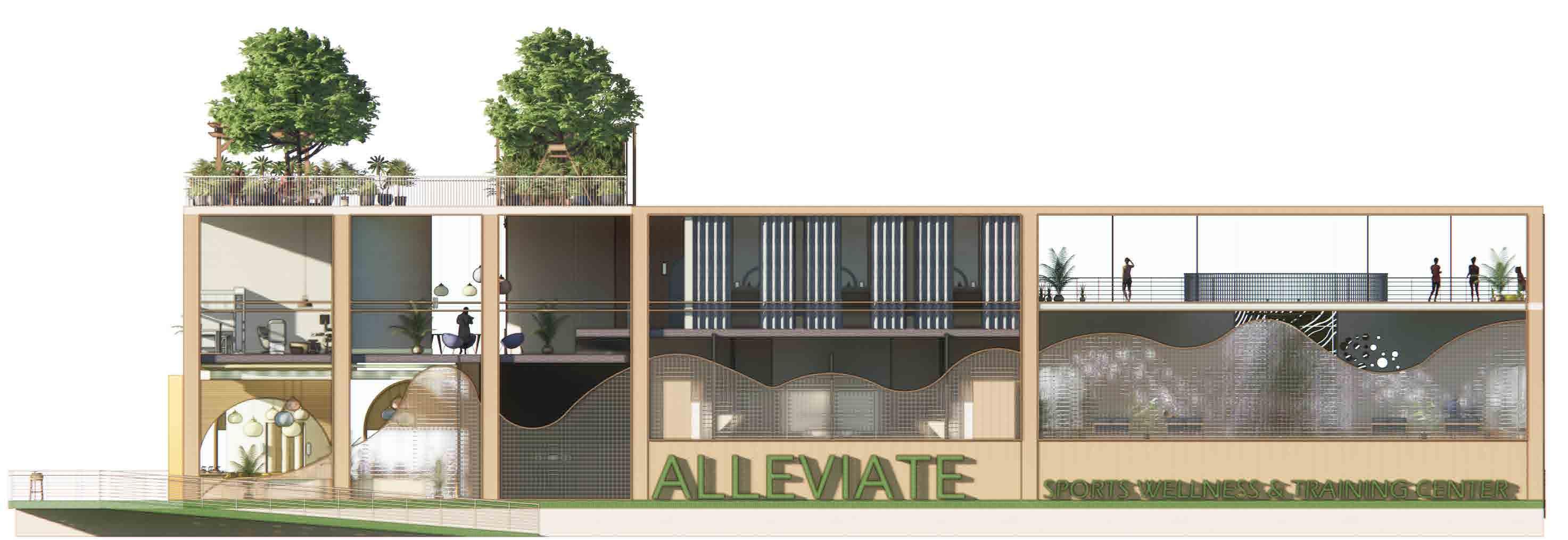
NORTH EAST EXTERIOR ELEVATION
SCALE : 1/16” = 1’-0”
RELECTION GARDEN
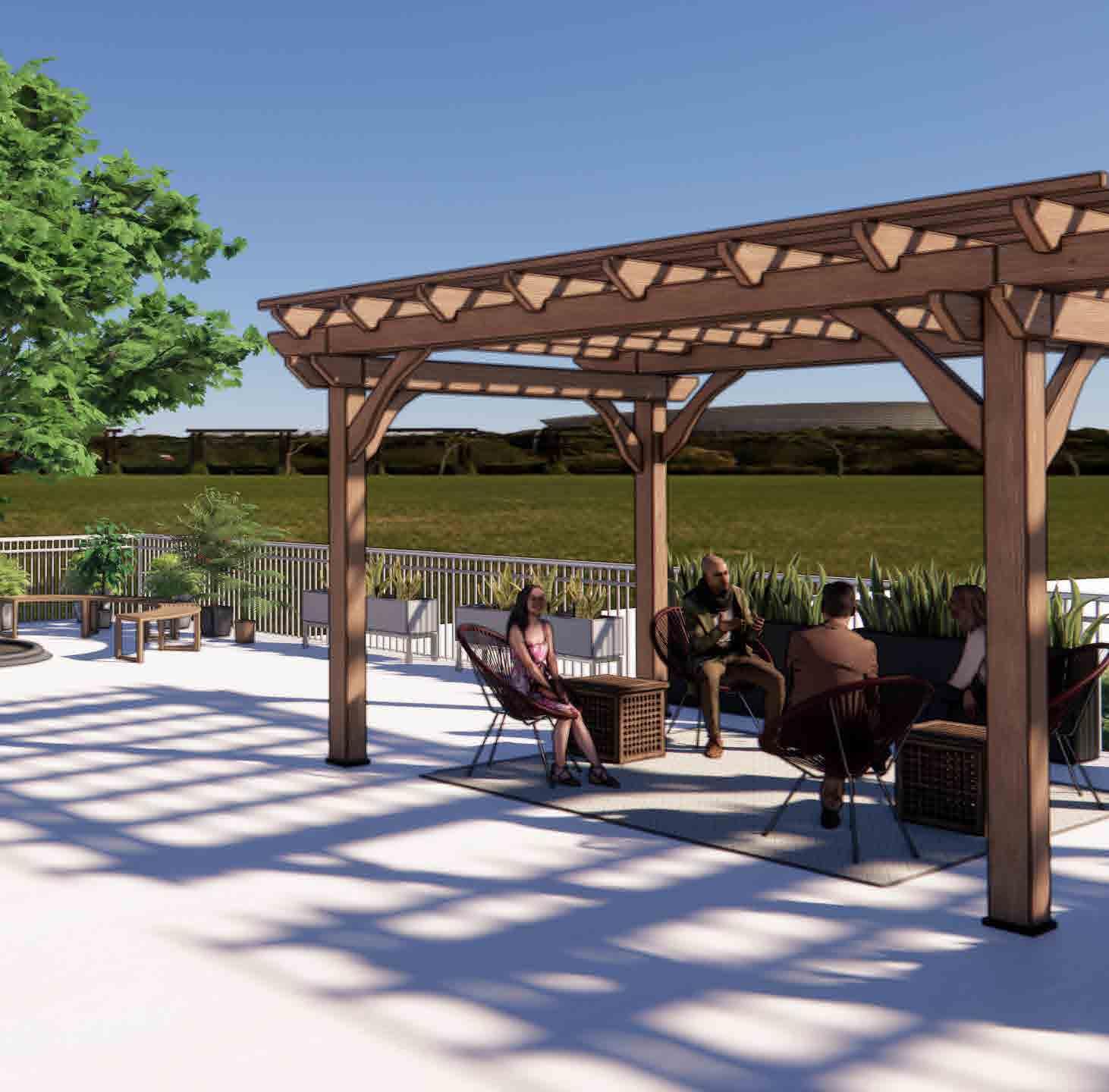
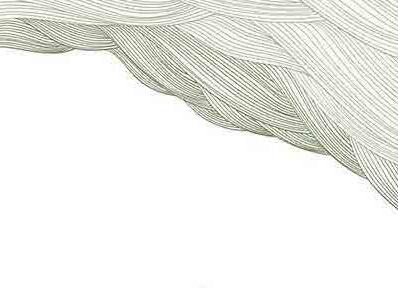
RELECTION GARDEN 3D AXON RENDERING


41

Ali Morris |16 August 2021 Leave a comment. (2022, November 24). Kyriakos Tsolakis architects blends resort for athlete rehabilitation into Mykonos Hillside. Dezeen. https:// www.dezeen.com/2021/08/16/kyriakos-tsolakis-architects-mykonos-wellness-resort/
Amy Peacock |24 October 2023 Leave a comment. (2023, October 24). Neri&Hu Wraps south china sea wellness retreat around “water courtyard.” Dezeen. https://www.dezeen. com/2023/10/24/neri-hu-sanya-wellness-retreat-hainan-hotel/
Anderson, T. M., & Williams, C. H. (2018). Exploring the Role of Coping Strategies in the Mental Health of Injured Athletes. *Journal of Sport Rehabilitation*, 28(4), 321-335. DOI:
Atkinson, M. (2019). Sport, mental illness and sociology. Emerald Publishing.
Balch, J. F. (n.d.). Prescription for natural cures: A self-care guide for treating health problems with natural remedies including diet, nutrition, supplements, and other holistic
Brown, K. J., & Wilson, D. M. (2020). Gender Differences in the Psychological Response to Sports Injuries: A Meta-analysis. *Journal of Sport Behavior*, 43(2), 187-203.
Designing for Physical, Psychological, and Spiritual Wellness: Assessing Interdisciplinary Service Learning Projects in Interior Design and Apparel Design and Merchandising. (n.d.). https://www.semanticscholar.org/paper/Designing-for-Physical%2C-Psychological%2C-and-Service-Thakur-Cao/cabe6db35308f29093d0ea55849090028bd54af5
Garcia, S. R., & Martinez, L. F. (2018). Sport-Related Injuries and Mental Health: An Exploratory Study of Adolescent Athletes. *International Journal of Sport Psychology*,
Higgins, M. (2012). Therapeutic exercise: From theory to practice. Jaypee Brothers Medical
High performance sports center: Longlists: Dezeen awards 2023. Dezeen. (n.d.). https:// www.dezeen.com/awards/2023/longlists/high-performance-sports-center/ Jones, L. M., & Davis, R. S. (2020). Understanding the Relationship between Sports Injuries and Mental Health: A Longitudinal Study. *Journal of Applied Sport Psychology*, 30(2), 7895. DOI: 10.1080/10413200.2020.1751650
Kottman, T. (2011). Play therapy: Basics and beyond. American Counseling Association. Kristine Klein |20 April 2020 Leave a comment. (2020, April 20). Studio Saxe adds plant-covered athletic centre to Costa Rican hotel. Dezeen. https://www.dezeen. com/2020/04/20/studio-saxe-athletic-centre-costa-rica-hotel/

BIBLIOGRAPHY
Miller, E. D., & Brown, S. M. (2017). The Intersection of Sports Injuries and Psychological Distress: Implications for Treatment and Rehabilitation. *Journal of Clinical Sport Psychology*, 11(4), 289305. DOI: 10.1123/jcsp.2017-0012
Patel, A. B., & Thomas, C. D. (2019). The Impact of Sports Injuries on Depression and Anxiety: A Longitudinal Examination. *Journal of Clinical Psychology in Medical Settings*, 26(2), 187-198. DOI: 10.1007/s10880-018-9581-0
Petersen, L. W., Bellar, J. C., Craig, D. M., & Cottingham, B. W. (n.d.). The current state of NCAA Division I collegiate strength facilities: Size, equipment, budget, staffing, and football status. Journal of strength and conditioning research. https://pubmed.ncbi.nlm.nih.gov/24476770/
Reardon, C. L. (n.d.). Mental health in elite athletes: International Olympic Committee Consensus statement (2019). s.n.
Reynolds, D., & Reason, M. (2012). Kinesthetic empathy in creative and cultural practices. Intellect.
Smith, J. K., & Johnson, A. R. (2019). The Psychological Impact of Sports Injuries: A Comprehensive Review. *Journal of Sport Psychology*, 25(3), 123-145.
Thompson, J. S., & Harris, M. L. (2017). Athletic Identity and Mental Health in Injured Athletes: A Qualitative Investigation. *Qualitative Research in Sport, Exercise and Health*, 9(3), 329-345. DOI: 10.1080/2159676X.2017.1294477
Thompson, K. R., & White, A. B. (2019). Psychological Factors Influencing Recovery from Sports Injuries: A Meta-analysis. *Psychology of Sport and Exercise*, 22, 100-108. DOI: 10.1016/j. psychsport.2015.07.003
Williams, R. L., & Davis, M. O. (2022). The Role of Social Support in the Psychological Adjustment to Sports Injuries. *Journal of Applied Sport Psychology*, 34(1), 45-60. DOI: 10.1080/10413200.2022.1888381















































































































































 SECOND FLOOR LOBBY
SECOND FLOOR 3D AXON RENDERING
SECOND FLOOR RECEPTION
SECOND FLOOR LOBBY
SECOND FLOOR 3D AXON RENDERING
SECOND FLOOR RECEPTION

















